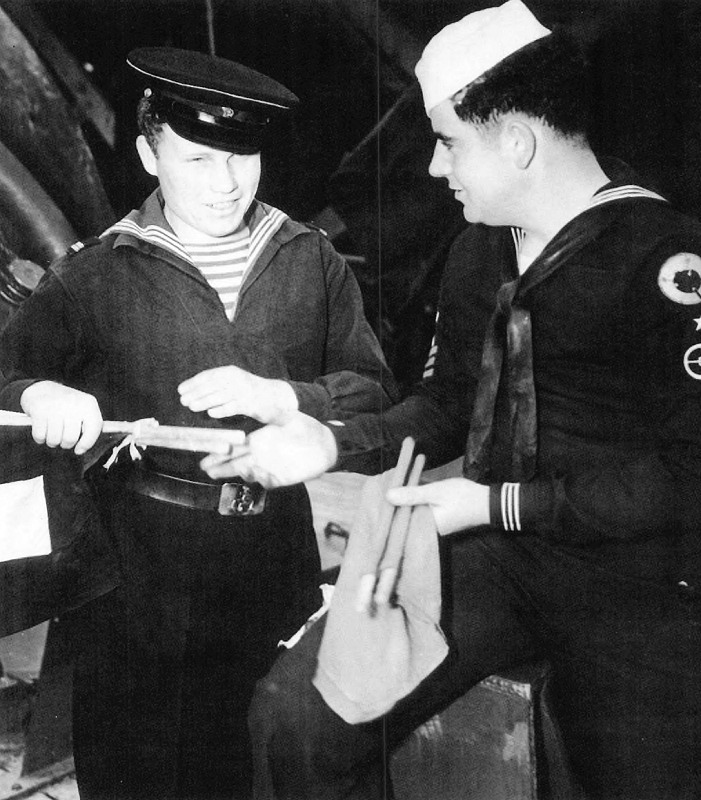
Project HULA required American and Russian sailors to work side by side in the largest and most ambitious transfer program of World War II. Its unique purpose was to equip and train Soviet amphibious forces for the climactic fight against Japan.
- - - - - - - - - - - - - - - - - - - - - - - - - - - - - - - - - - - - - - - - - - - - - -
Secretary of the Navy's
Advisory Subcommittee
on Naval History
Dr. David Alan Rosenberg, Chair
CDR Wesley A.
Brown, CEC, USN (Ret.)
Dr. Frank G. Burke
Mr. J. Revell
Carr
VADM Robert F. Dunn, USN (Ret.)
VADM George W. Emery, USN
(Ret.)
Dr. Jose-Marie Griffiths
Dr. Beverly Schreiber
Jacoby
Mr. David E. Kendall
Mr. Harry C. McPherson, Jr.
The
Honorable G.V. Montgomery
Dr. James R. Reckner
Dr. William N.
Still, Jr.
ADM William O. Studeman, USN (Ret.)
Ms. Virginia S.
Wood
Library of Congress Cataloging-in-Publication Data
Russell, Richard A., 1957 –
Project HULA : secret Soviet-American naval cooperation in the war
against Japan / by Richard A. Russell.
p. cm. — (The U.S.
Navy in the modern world series ; no. 4) ISBN 0-945274-35-1 (alk.
Paper)
1. World War, 1939-1945—Naval operations, American. 2. Military assistance, American—Soviet Union. 3. United States— Military relations—Soviet Union. 4. Soviet Union—Military relations—United States. I. Title. II. Series.
D773.R87 1997
940.54'5973—dc21
97-7022
The paper used in this publication meets the requirements for permanence established by the American National Standard for Information Sciences "Permanence of Paper for Printed Library Materials" (ANSI Z39.48-1984).
For sale by the U.S. Government Printing
Office
Superintendent of Documents, Mail Stop: SSOP, Washington,
DC 20402-9328
ISBN 0-16-049376-5
- - - - - - - - - - - - - - - - - - - - - - - - - - - - - - - - - - - - - - - - - - - - - -

Project
HULA required American and Russian sailors to work side by side in
the largest and most ambitious transfer program of World War II. Its
unique purpose was to equip and train Soviet amphibious forces for
the climactic fight against Japan.
- - - - - - - - - - - - - - - - - - - - - - - - - - - - - - - - - - - - - - - - - - - - - -
“The visitors included many officers whom the United States Navy would be pleased to have, and . .. the visiting enlisted men were well disciplined, energetic and extraordinarily hard-working, and often the equal of American personnel. . . . The visitors demonstrably possess the essentials of a major naval power.”
Captain William S. Maxwell to Fleet Admiral Ernest J. King
27
September 1945
- - - - - - - - - - - - - - - - - - - - - - - - - - - - - - - - - - - - - - - - - - - - - -
For Marie, and in memory of my father-in-law, Bruno J. Martini (1935-1996)
- - - - - - - - - - - - - - - - - - - - - - - - - - - - - - - - - - - - - - - - - - - - - -
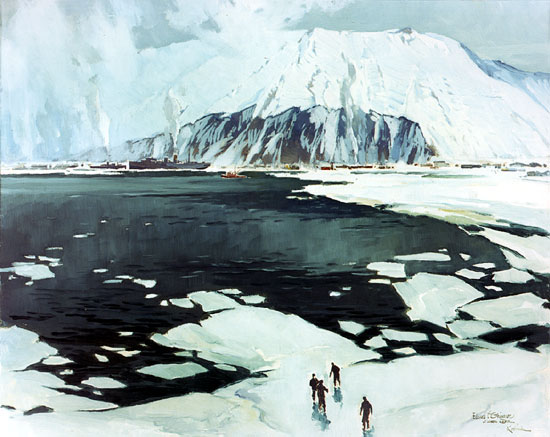
Navy
Art Collection, Naval Historical Center
On the cover, "Ice Floes, Kodiak" (undated), an oil painting by Lieutenant Commander Edward T. Grigware, USNR. The stark, frozen landscape of an Alaskan winter is beautifully illustrated in this painting. Grigware completed this piece during the war, probably after 1943.
- - - - - - - - - - - - - - - - - - - - - - - - - - - - - - - - - - - - - - - - - - - - - -
This study is the fourth in the Naval Historical Centers series, "The U.S. Navy in the Modern World," that aims to acquaint naval officers, sailors, and other readers with the U.S. Navy's unique contribution to national security, economic prosperity, and global presence in the contemporary period.
Starting in the Second World War, the United States assumed the leadership of major multinational politico-military coalitions, first to destroy fascism and later to thwart the spread of communism. Military assistance programs, in which the American armed services helped their foreign counterparts to help defend themselves, served a vital if unheralded role in the common defense. Such programs, so familiar today, originated with the timely creation of the lend-lease program of World War II.
This booklet, based on original materials culled from archives in the United States and in the Russian Federation, treats a little known aspect of lend-lease and of Soviet-American relations at the end of the Second World War. The author, Richard A. Russell, has cultivated singularly productive relations with prominent historians, archivists, and naval officers in Russia. His tireless efforts to obtain access to Russian naval archives and to introduce their materials into the writing of recent American history will revise how historians approach working on the naval aspects of the Soviet-American alliance in World War II and the Cold War at sea.
In addition to Mr. Russell's efforts, I am pleased to acknowledge those individuals who contributed to this publication, including Dr. Edward J. Marolda, our Senior Historian and founder of the series; Dr. Gary E. Weir, head of the Contemporary History Branch and editor of the series; many of the professional staff of the Naval Historical Center, especially the members of the Naval Aviation News Branch; and the other scholars and professionals at institutions in the United States and the Russian Federation. Finally, I am grateful to the U.S. Navy's World War II Commemorative Committee for their help in producing this publication.
The views expressed are those of Richard A. Russell alone and not necessarily those of the Department of the Navy or any other agency of the U.S. government.
William S. Dudley
Director of Naval History
- - - - - - - - - - - - - - - - - - - - - - - - - - - - - - - - - - - - - - - - - - - - - -
In the 1930s, the potential for cooperation between the United States and the Soviet Union to restrain Japan—one of the unspoken objects behind Washington's decision to recognize the Moscow regime in 1933—did not evolve into any concrete strategy beyond wistful ideas and a few hollow gestures. By the end of the decade, both countries adopted independent policies toward Japanese aggression in Asia.
In 1939, Soviet forces won a bloody border war against Japan. Japanese attention then turned toward the Asian possessions of the colonial powers. At the same time, in Europe, the Soviet Union and the Western democracies failed to reach an agreement on how to deal with Germany's threat to the peace. To the dismay of the West, Soviet leader Josef Stalin and German dictator Adolf Hitler completed the infamous Nazi-Soviet Non-Aggression Pact, which included a scheme to divide Poland between them. Within a week, Germany attacked Poland, which prompted Great Britain and France to declare war on Germany, igniting World War II.
The Soviet Union and United States stayed out of the growing conflict until June and December 1941, respectively, when Germany attacked the Soviet Union and Japan attacked the United States. When Germany and Italy then declared war on the United States, the alliance between the U.S. and the USSR, which appeared improbable only months before, was forged. In Asia, however, Japan and the Soviet Union managed to preserve, in the words of historian George Alexander Lensen, their "strange neutrality." By December 1941, the staggering success of the German attack in European Russia left Stalin with little means and no desire to open the two-front war against Japan sought by President Franklin D. Roosevelt. Japans subsequent acquiescence to the movement of vital lend-lease supplies to the Soviet Far East via the North Pacific ensured Soviet neutrality in Asia while the European war raged.
This situation prevailed until 1945, with a regular ebb and flow of hope and frustration on the U.S. side, which sought basing rights for heavy bombers in Siberia and suffered concern for the security of the lend-lease route. At the Yalta Conference in February 1945, however, the United States secured Soviet entry into the war against Japan by pledging to provide military support and several important territorial considerations, including turning over the Kuril Islands to the Soviet Union.
In the spring and summer of 1945, a special detachment of the United States Navy trained some 12,000 Russian officers and men in the handling of naval vessels scheduled for transfer to the Soviet Pacific Ocean Fleet under the lend-lease program. Project HULA required American and Russian sailors to work side by side in the largest and most ambitious transfer program of World War II. Its unique purpose was to equip and train Soviet amphibious forces for the climactic fight against Japan.
- - - - - - - - - - - - - - - - - - - - - - - - - - - - - - - - - - - - - - - - - - - - - -
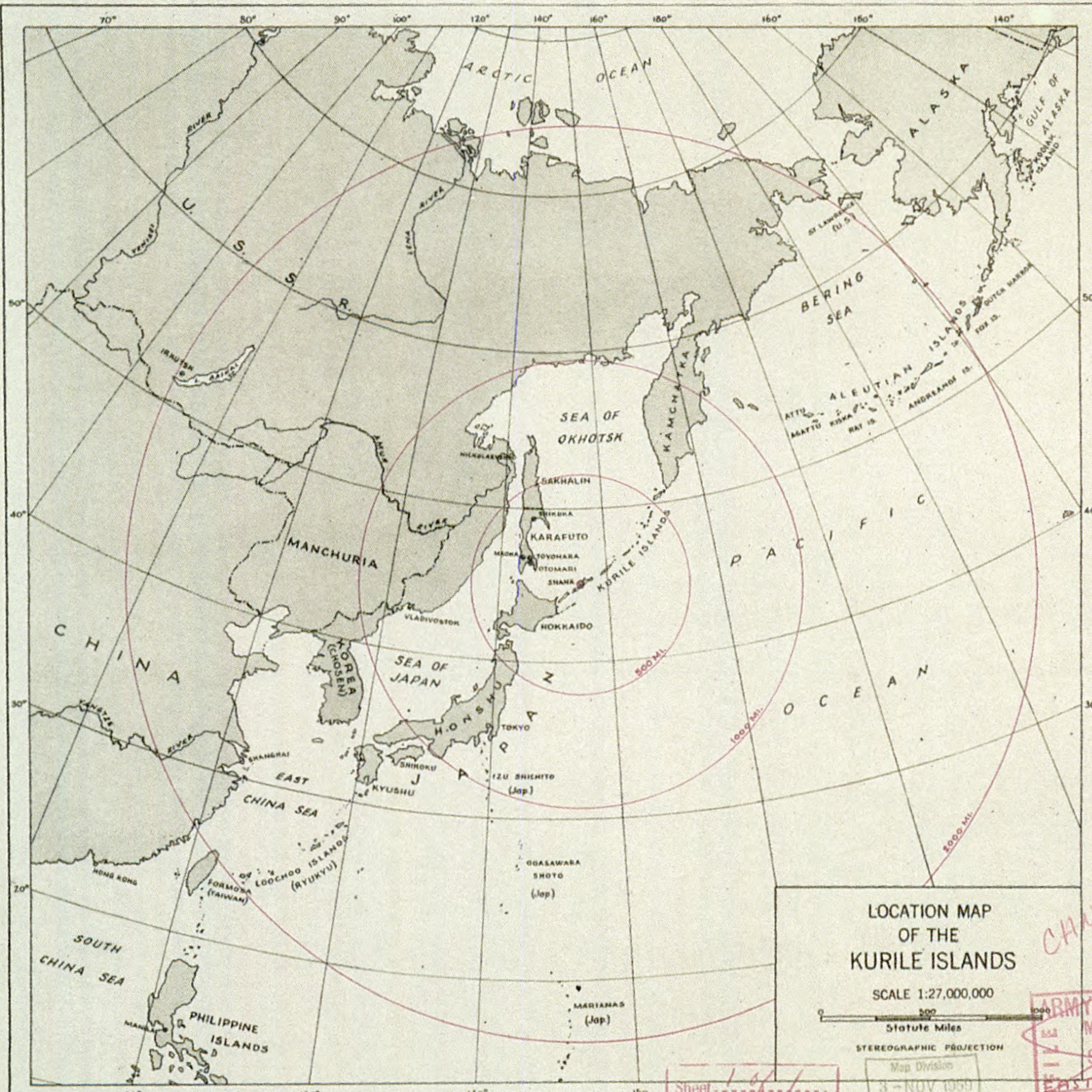
The map shows the location of the Kuril Islands and the Aleutian Islands in relation to the Pacific. The U.S. agreed to Soviet control of the Kuril Islands as a condition to that country's entry into the war against Japan.
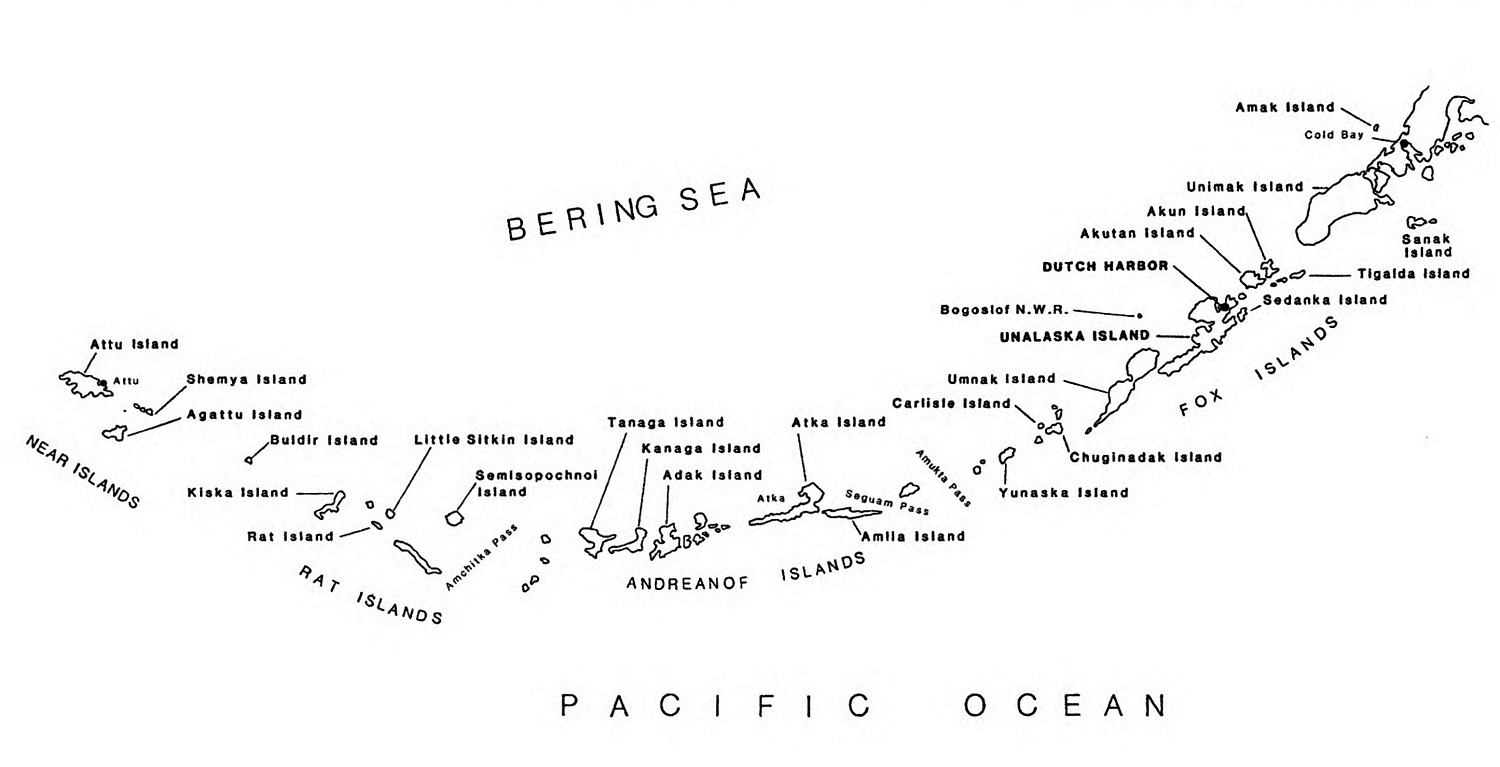
The close-up of the Aleutian Islands below shows the location of Cold Bay, in the upper right.
- - - - - - - - - - - - - - - - - - - - - - - - - - - - - - - - - - - - - - - - - - - - - -
Since 1905, when Japan emerged victorious in the Russo-Japanese War, observers in both the United States and Russia had envisioned cooperation against Japan. Leon Trotsky, a principal leader of the Bolshevik Revolution in 1917 and founder of the Red Army, saw Russia and America as "two arms of a nutcracker," able to crush Japan if their ideological antipathy could be overcome. In the United States, armchair strategists believed the proximity of Russian and American territory in the North Pacific made those icy waters a logical theater for future cooperation against Japan. President Woodrow Wilson and successive Republican administrations of the 1920s, however, refused to establish relations with the Bolshevik regime. V. I. Lenin—the leading figure in the Communist Party and head of the Soviet government until his death in 1924—and his cohorts advocated the overthrow of the western capitalist democracies and supported activities meant to achieve that end. Therefore in the eyes of many Americans the Soviet Union did not merit the moral support implied by diplomatic recognition.
Japan's bold military thrust into Manchuria in 1931, which placed Japanese and Soviet armed forces on opposite sides of a common border, prompted renewed thinking in Moscow and Washington about the practical benefits of Russian-American politico-military cooperation. At the same time the Soviet Union had improved its international standing by not only signing non-aggression pacts with Finland, Estonia, Latvia, Poland and France in 1932 but in its industrialization program and apparent imperviousness to the Depression. Thus, in spite of the Kremlin's disturbing ideology, its enhanced prestige and the rise of Japanese militarism afforded President Franklin Roosevelt the opportunity to extend diplomatic recognition to the communists in 1933, his first year in office.
As a result, the chilly political climate seemed to warm. In 1936, Stalin opened negotiations with American firms for the design of a new class of battleship, with a prototype vessel to be built in an American yard. To ensure official support for the deal, Stalin offered to station one of the battleships in the Soviet Far East. Nothing came of the negotiations, which dragged on for three years, because key officers within the Navy Department, including Chief of Naval Operations (CNO) Admiral William D. Leahy, opposed the transaction. It is probably fair to conclude that the Soviet Unions extensive campaign of espionage in the U.S. (including attempts to acquire plans for major combat ships and other industrial secrets), which kept the Office of Naval Intelligence (ONI) very busy in the 1930s, contributed to the Navy Department's wariness in dealing with the Soviet Union.
Moscow also pressed Washington for a warship visit to the Soviet Far East. In late July 1937, Admiral Harry E. Yarnell, commander-in-chief of the Asiatic Fleet, took his flagship, the heavy cruiser Augusta (CA 31), and four destroyers to Vladivostok, the main Soviet naval base in the Pacific, for an official port visit. If either party to this traditional gesture of solidarity wished to impress the Japanese, however, the timing could not have been worse. Several weeks before Yarnell's arrival, Japanese border forces had dealt a stinging blow to Soviet prestige when they bested the Red Army in a major border clash at Kanchatzu Island on the Amur River. Shortly after that episode, on 7 July, Japanese and Chinese troops skirmished near the Marco Polo Bridge outside of Peking, precipitating the Sino-Japanese War of 1937-1945.
The Soviet Union and the United States both sympathized with China, but Roosevelt proved unwilling to articulate publicly his desire for greater cooperation with Stalin's regime. In December, Japanese aircraft sank the U.S. gunboat Panay (PR 5) on the Yangtze River. Though Japan proved increasingly hostile, neither the United States nor the Soviet Union seemed prepared to confront Japan, either as partners or unilaterally.
During 1938 and 1939, antagonism between the Soviet Union and Japan escalated into major armed confrontations. Reasoning that it might be drawn into the Imperial Japanese Army's fight with the Soviet Union, the Imperial Japanese Navy in 1938 drafted contingency plans for a carrier strike on Vladivostok. Meanwhile, the Red Army fortified Vladivostok and the Soviet navy imported a substantial fleet of small submarines to Vladivostok via the Trans-Siberian Railroad. In the summer of 1939, Soviet and Japanese armies fought a bloody war on the border between Moscow's protectorate, Outer Mongolia, and Tokyo's puppet regime in Manchuria, Manchukuo. The Red Army, however, won this bloody bout—the Battle of Nomonhan—and deflected Japanese ambition southward, in the direction desired by the Imperial Navy.
Within days of the victory at Nomonhan, Stalin concluded a non-aggression pact with German dictator Adolf Hitler. A secret protocol provided for the partition of Poland between them. On 1 September, German forces invaded Poland, which caused Great Britain and France to declare war on Germany, igniting the Second World War. The outbreak of war in Europe convinced the Soviet Union of the need to reach a similar agreement with Japan. Meanwhile, as it became bogged down in China and its relations with the United States deteriorated, Japan seemed more inclined to improve its international position by reaching a settlement with the Soviet Union. The Asian adversaries signed a neutrality pact on 13 April 1941.
Although the United States and the Soviet Union remained neutral in the growing conflagration until 1941, they were fated to be drawn into the fighting. On 22 June 1941, Germany invaded the Soviet Union. Under the leadership of Prime Minister Winston S. Churchill, the British began convoying supplies to the Soviet Union in August. On 7 November, the 24th anniversary of the Bolshevik Revolution, Roosevelt announced, "I have today found the defense of the Union of Soviet Socialist Republics vital to the defense of the United States." He ordered the Office of Lend-Lease Administration to make every effort to provide military and economic aid to the Soviet Union in its war against Nazi Germany. Going even further, Roosevelt authorized the immediate allocation of $1 billion from funds already appropriated for lend-lease. Thus, despite nearly a quarter of a century of antagonism and distrust, Roosevelt made the momentous decision to support Germany's new enemy. Roosevelt's fear of a German victory or a Soviet-German peace that would leave Hitler in control of the Eurasian land mass and facilitate a German-Japanese juncture outweighed his animosity toward Moscow and any domestic political liabilities such a rapprochement would create. Besides, the Russians were killing more Germans than any other nation at war. Their valor quickly won official and public admiration in Great Britain and the United States.
A month after Roosevelt's declaration, the Red Army fought a desperate battle for Moscow. Fresh troops arriving by train from the Far East made subway connections into the city's western outskirts, where they met the German spearheads and stopped them cold. On 7 December, Japan tossed aside America's neutrality by attacking the United States Pacific Fleet at Pearl Harbor. Within days, both the United States and Chinese governments sought to enlist the Soviet Union's help in the war against Japan. Yet the immensity of Germany's military success in the east prevented a Soviet second front in Asia. On 11 December, Ambassador Maxim Litvinov informed Secretary of State Cordell Hull that the USSR was in no position to cooperate with the United States against Japan. Hull reported to President Roosevelt that "Russia was fighting on a huge scale against Germany and could not risk an attack by Japan." Attempts to include the Soviet government in strategic planning for the Far East also failed. Because of concerns that hostilities might break out at any time between Japan and the USSR, however, Roosevelt directed planners to develop studies of possible joint action.
In December 1941, during the Arcadia conference in Washington, at which the British and American Combined Chiefs of Staff (CCS) met for the first time to discuss Anglo-American military objectives, the chiefs determined that the Soviet Maritime Province had to be held. The question of Soviet participation in the war against Japan continued to be raised in Washington during 1942, both because of the possibility that Japan might attack the Soviet Far East and because of the hope of establishing American heavy bomber bases in Siberia.

During
the war, Soviet navy personnel received training on American
lend-lease vessels, aircraft, and equipment at U.S. Navy facilities
in the United States. In Project Zebra (1944-1945), the U. S. Navy
trained Soviet naval aviators on the Catalina at Elizabeth City Naval
Air Station, N.C. The Soviet navy received some 200 Catalinas under
this program, several of which took part in the August-September 1945
campaign against Japanese forces. In this photograph from June 1944,
Soviet naval aviation personnel and their American hosts line up in
front of a Catalina.
No detailed planning for Soviet participation in the Pacific War could be done, however, without information on Soviet military capabilities and plans in the Far East. "It would be unwise for the United States to undertake active operations in Siberia," the Joint Chiefs advised, "until after its military officials were in possession of complete information as to Soviet strengths and plans, and unless the validity of this information had been confirmed by a careful and exhaustive examination, by United States officers, of Soviet forces and facilities in the Siberian theater." In a memorandum to Roosevelt on the subject, Army Chief of Staff General George C. Marshall and Commander in Chief, U.S. Fleet (COMINCH) and Chief of Naval Operations Admiral Ernest J. King noted how difficult it was for American military authorities to obtain sufficient data on the Soviet armed forces. Indeed, this problem continued to plague American planners throughout the war. Marshall and King urged the president to promote collaboration more actively.
Japan's occupation of Attu and Kiska in the Aleutian Islands chain in early 1942 again drew attention to possible Soviet-American cooperation in the North Pacific. On 17 June, Roosevelt dispatched a message to Stalin in which he indicated that the North Pacific situation was developing "to where tangible evidence is presented that the Japanese possibly are getting ready to conduct operations against the Soviet Union Maritime Provinces." In the event of such an attack, the president pledged U.S. military assistance in the form of air power, "providing there are available in Siberia landing fields which are adequate." He also recommended the initiation of secret staff conversations between American and Soviet navy, army, and air force representatives.
When Stalin did not immediately reply, the President sent a second message on 23 June. In this dispatch Roosevelt proposed an Alaskan-Siberian ferry route. He also stressed the importance of allowing Americans to enter Russian territory for the purpose of surveying potential airfield sites and to improve aids to navigation. Soon after the Pearl Harbor attack, therefore, the American side had laid out its chief aims with regard to the Soviet Union: continued lend-lease support; strategic coordination; and joint participation in the war against Japan, which would include the use of Siberia for American aircraft. Stalin, however, steadfastly resisted all efforts to involve the Soviet Union in the Pacific War while the defeat of Germany still lay far in the future.
The subject of Soviet participation in the war against Japan received only minor attention during the four major Allied conferences held in 1943. At the first, the January Casablanca Conference, the British and American military chiefs focused on strategy for defeating Germany. The U.S. Joint Chiefs of Staff (JCS), however, decided that the Aleutian chain should be made as secure as possible, both to check Japanese expansion and to serve as an advance staging area for Soviet-American operations. In a message to Stalin summarizing the results of the conference, Roosevelt and Churchill emphasized the appropriateness of their policy of focusing on Germany first, but pointed out the Allied need to retain the initiative in the Pacific and Far East, sustain China, and "prevent the Japanese from extending their aggression to other theaters such as your Maritime Province."
At the Washington conference in May, British and American military leaders met again. Their restatement of Allied strategy noted the desirability of Soviet participation in the war against Japan. The Allied chiefs agreed to the expulsion of Japanese forces from the Aleutian Islands, but considered that "our present strategic concept does not contemplate further amphibious operations west of the Aleutians. Our forces there will assume a defensive role until conditions are favorable to operations in support of Russia in the Kamchatka Peninsula—Siberian area." Roosevelt and Churchill agreed to the concept. Accordingly, that May and August Allied forces recaptured Attu and Kiska islands. At the third Allied conference of 1943, held in Quebec in August, Roosevelt and Churchill reaffirmed the overall strategic concept.
The JCS estimate on a potential Soviet-Japanese war prepared for the conference presaged the coming event:
There exists between Russia and Japan a basic conflict of interest. Japan cannot enjoy complete strategic security without gaining control of the eastern region of Siberia. Russia is determined to hold that region, the strategic security of which requires the ultimate expulsion of Japan from the mainland of Asia and from southern Sakhalin. For the present, however, both Russia and Japan desire to avoid war with each other in order to be free to direct their efforts against their respective enemies. Russia is likely to intervene in the war against Japan at some stage, but not before the German threat to her has been removed. After that, she will make her decision in the light of her own interests and will intervene only when she reckons that Japan can be defeated at a small cost to her.
In October 1943, Moscow hosted a meeting of the Allied foreign ministers. Secretary of State Cordell Hull led the American delegation, which included W. Averell Harriman, the new U.S. ambassador to the Soviet Union, and Major General John R. Deane, U.S. Army, who stayed on to head the newly created U.S. Military Mission in Moscow. Discussion necessarily revolved around European political and military issues, including the establishment of a second front in Europe. The Soviet participants informally indicated that their government was moving closer to participation in the Pacific War. According to Secretary Hull, Stalin "clearly and unequivocally" stated "that, when the Allies succeeded in defeating Germany, the Soviet Union would then join in defeating Japan." This commitment, however, did not appear in the conference protocols. In their point paper, the JCS pointed out in no uncertain terms the "great importance to the United States of Russia's full participation in the war against Japan after the defeat of Germany." They saw this as "essential to the prompt and crushing defeat of Japan at far less cost to the United States and Great Britain."
Roosevelt, Churchill and Stalin met for the first time at Teheran, Iran, in late 1943. Though European affairs dominated the agenda proposed by the Anglo-American Combined Chiefs of Staff, the role of the USSR in the Pacific War figured in five of their discussion points. The CCS wanted 1) Soviet intelligence information on Japan; 2) to know if Stalin considered it desirable to begin preparations for basing Soviet Pacific Fleet submarines on American territory; 3) to learn what direct or indirect assistance the Soviet Union would provide if the United States decided to attack the northern Kuril Islands; 4) to know what Soviet ports the U.S. Navy could use and the logistical and geographical characteristics of such ports; and 5) to learn what air bases, if any, American air forces could use for operations against Japan.
As it turned out, the Anglo-American staff did not discuss the war against Japan during their meeting at Teheran with their Soviet counterparts. The CCS merely reaffirmed the strategic concept approved at the Washington Conference of May 1943.
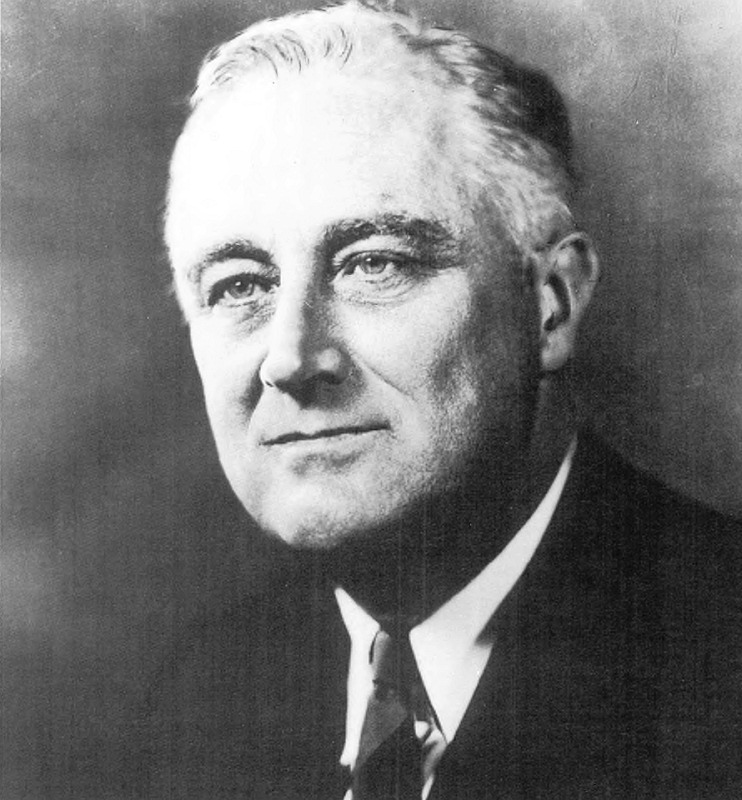
Franklin
D. Roosevelt (1882-1945), 32nd President of the United States.
An American intelligence estimate on Russo-Japanese relations done at that time predicted continued neutrality, because the Soviet government still feared the consequences of a premature break with Japan, and the Japanese could not afford another enemy On 28 November 1943, Stalin replied to Roosevelt's review of the Pacific War:
We Soviets welcome your successes in the Pacific. Unfortunately we have not so far been able to help because we require too much of our forces on the Western Front and are unable to launch any operations against Japan at this time. Our forces now in the East are more or less satisfactory for defense. However, they must be increased about three-fold for purposes of offensive operations. This condition will not take place until Germany has been forced to capitulate. Then by our common front we shall win.
The next day, Roosevelt presented Stalin with the five discussion points, stressing his belief in the imperative need to begin joint planning for eventual Soviet participation in the Pacific War at once. Stalin promised to study the questions relating to the Far East following his return to Moscow. About a month later, Soviet Foreign Minister Vyacheslav M. Molotov informed Ambassador Harriman that the Soviet Union would provide information about the Japanese, but that the other questions could not be immediately resolved.
In October 1944, when Churchill, Ambassador Harriman, and Major General Deane met with Stalin in Moscow, the Soviet leader revived hopes for military collaboration against Japan with a pledge to commence offensive operations three months after the defeat of Germany. Stalin also stipulated that the Allies must build up a reserve of supplies and equipment prior to Soviet entry into the war. This being a wise precaution, given the belief in Japans ability to disrupt the flow of troops and supplies arriving in the Far East via the Trans-Siberian Railway, the Allies wasted little time in fulfilling Stalin's condition.
Deane took personal charge of this project. Accordingly, Soviet representatives presented him with a list of needed supplies. They wanted this list to be considered separately from the supplies already allocated to them under the annual lend-lease agreement. Deane treated the requisition as a military project, working through the JCS rather than the lend-lease programs Soviet Protocol Committee. The Joint Logistics Committee (JLC) of the JCS approved the request, now code-named MILEPOST, with the proviso that its fulfillment not adversely affect the existing or anticipated operations in either Europe or the Pacific.
On 5 December 1944, even as a subcommittee of the JLC pondered the original MILEPOST list, Admiral V. A. Alafusov, Chief of the Soviet Main Naval Staff, presented to Rear Admiral Clarence E. Olsen, Head of the Navy Division of the U.S. Military Mission in Moscow, a second list of ships and material necessary to equip the Soviet Pacific Fleet for war. Alafusov wanted the new list to supersede the naval requirements outlined in MILEPOST. To establish priorities and allay confusion, Olsen insisted that they reconcile both lists and submit one final request to Washington. On 20 December, Olsen and Alafusov agreed to a single list of vessels, aircraft, and equipment. The revised request identified some two dozen types of ships and aircraft, from escort vessels and minesweepers to flying boats and torpedo-carrying A-26 light bombers, as well as a variety of port equipment and electronic components.
While Alafusov and Olsen negotiated Soviet requirements, Deane reported to Washington that Olsen also "considers it urgent that a program for training of personnel and for delivery of some of each type of ship should be set up at once" to instruct the Soviet crews in the operation of U.S. ships. Although Deane and Olsen agreed that Soviet needs were worthwhile, they also believed that it was undesirable "to withdraw any ships from active combat longer than required for turnover."
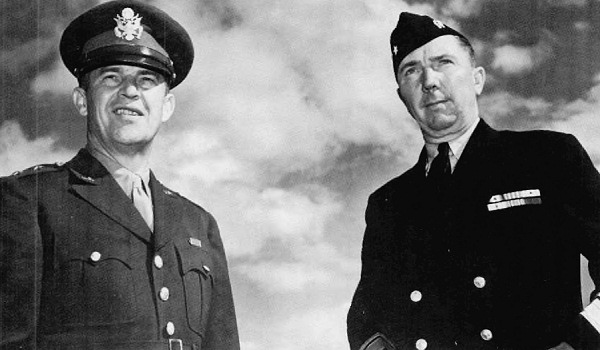
Leaders
of the U.S. Military Mission in Moscow, 1943-1945. Major General John
R. Deane (l) led the mission. Rear Admiral Clarence E. Olsen (r),
head of the Navy section, served as Deane's deputy.
In early January 1945, Fleet Admiral N. G. Kuznetsov, Peoples Commissar for the Soviet navy (its commander in chief), inquired into the feasibility of receiving the MILEPOST ships in the Aleutian Islands, perhaps at Dutch Harbor, "in order to better preserve [the] security of turnover."
Dutch Harbor on Unalaska Island seemed a sensible choice, given its existing facilities and familiarity to the Soviet navy and merchant marine, especially the latter, whose vessels regularly called there and at nearby Akutan. On 18 January 1945, Fleet Admiral King informed Vice Admiral Frank Jack Fletcher, Commander of the North Pacific Force, of his intention to transfer about 250 naval vessels and craft to the Soviet Union during the period between April and December 1945. Given the large number of ships and men involved, King asked Fletcher to comment on the feasibility of the operation in regard to the available housing, messing, shakedown and technical training facilities at Dutch Harbor. King indicated that "during no month will personnel requirements exceed about 2500, and that turn over time will not exceed two weeks." Fletcher responded on 29 January, rejecting Dutch Harbor as the proposed site:
I do not consider Dutch Harbor feasible because 2500 personnel will crowd Navy housing and messing facilities. Overflow must use vacant Army quarters inconveniently located. Ships involved will congest harbor. Very limited protected waters available for shake down training. Technical training facilities non existent.
Fletcher instead recommended Cold Bay, with Kodiak and Dutch Harbor as his second and third choices, respectively. He reported that Cold Bay (the location of the Army's Fort Randall and, until recently, a Navy air auxiliary facility) had ample, conveniently located housing and messing facilities. Cold Bay also had the best protected waters in the area under Fletcher s control and no civilian population to complicate security. While Kodiak had sufficient housing and messing facilities, it lacked protection from heavy seas. Fletcher recommended further that repair facilities be provided at the location selected and that interpreters be furnished. He reported that the commanding general of the U.S. Army's Alaskan Department concurred with his views. On 6 February, King informed Deane of the selection of Cold Bay "as the most suitable transfer point" for turning over the proposed vessels to the Soviet navy.
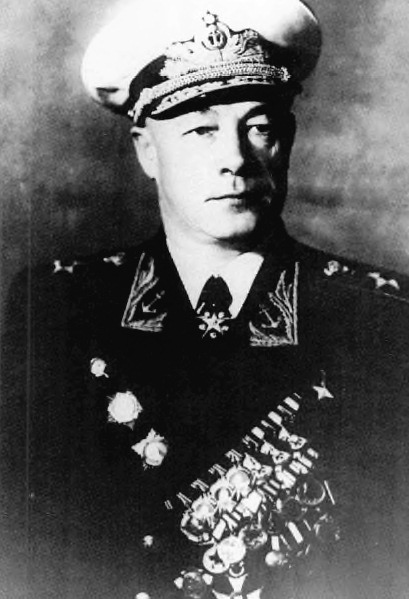
Fleet
Admiral Nikolai Gerasimovich Kuznetsov (1904-1974). People's
Commissar and Commander in Chief of the Navy of the USSR from
1939-1946. Named Hero of the Soviet Union in 1945. Though demoted
after the war, Kuznetsov returned in 1951 to the upper ranks of
government, serving concurrently as the Naval Minister, a First
Deputy Minister of Defense, and Navy Commander in Chief. In 1956, he
was again relieved and demoted. With the Soviet Union's collapse in
1991, he was rehabilitated. To honor him, in 1992 the Russian navy
changed the name of Tblisi, its new heavy
aircraft carrier, to Admiral of the Fleet of the Soviet
Union Kuznetsov.
When Fletcher reported on the difficulties that allocating personnel to rehabilitate the barracks and other facilities at Cold Bay would create, King sent a message on 8 February asking if he wished to change his recommendation. In the same dispatch, however, King encouraged Fletcher to stick with Cold Bay by offering to send a training team to run the transfer program.

Snow-covered
U.S. Navy Catalina seaplane of Patrol Wing 4 in front of a nose
hangar at Naval Section Base, Cold Bay, November 1942. In February
1943 the Navy reclassified the base as an air auxiliary facility.
There was good reason for wishing to use Cold Bay: Kuznetsov had already agreed to it. On 8 February, while King and the other chiefs were in the Crimea with Roosevelt for the Yalta Conference, the topic of the transfer base came up. At the outset, Kuznetsov stated that Kodiak was the Soviet government's second preference for a transfer site after Dutch Harbor. King then informed him that he had chosen Cold Bay. Though unfamiliar with the base, Kuznetsov found it on the map and immediately approved. Five days later, Fletcher responded to King's dispatch, stating that Cold Bay remained his first choice.

Above,
Soviet Fleet Admiral N. G. Kuznetsov and American Fleet Admiral
Ernest J. King upon the latter's arrival at Yalta for the Crimean
Conference in February 1945.

Below,
the Big Three wartime leaders, seated left to right: British Prime
Minister Winston S. Churchill, American President Franklin D.
Roosevelt, and Soviet Generalissimo Josef V. Stalin met at Yalta in
the Crimea in early February 1945. Fleet Admiral Ernest J. King is
standing to the rear of Churchill. Fleet Admiral William D. Leahy is
standing behind the President, obscuring General of the Army George
C. Marshall.
A directive issued by King about one week after the end of the Yalta Conference officially established the transfer program. On 15 February, he ordered Fletcher to proceed with the rehabilitation of the Army barracks at Cold Bay. As promised, an officer in charge of training and his staff would report by 24 March. The Soviet personnel would arrive in increments—2,300 by 1 April, an additional 550 by 1 May, and 2,000 more by 1 June. The program had evolved into its final form, with the staff of the Chief of Naval Operations, the staffs of Nimitz and Fletcher, and American personnel in Moscow coordinating the details both with each other and with Soviet officials.
Soviet and American representatives in Moscow resolved the question of how the Soviet sailors would arrive in Alaska. At Yalta, Kuznetsov had proposed transporting Soviet sailors across the Atlantic Ocean and the continental United States. Soviet crews could travel in empty convoy ships on their return leg to North America, King had suggested, but the poor shipping situation in the Pacific would present great difficulties in moving the crews from the U.S. West Coast to Alaska. The Soviet admiral had not offered to transport them in Soviet vessels, so the two naval chiefs deferred the matter.
In Washington, on the day after the Yalta Conference, Admiral A. A. Yakimov, Deputy Chairman of the Soviet Government Purchasing Commission, took a different approach. He requested that the United States transfer three Liberty ships or similar vessels to Soviet registry—a practice the United States heretofore had reserved for the Pacific Theater— to transport Soviet sailors to Alaska. This request implied Moscow's willingness to consider use of the North Pacific route.
American planners sought ways of reducing the number of Soviet sailors who required transportation to United States ports. On 24 February, Vice Admiral Richard S. Edwards, Deputy COMINCH, informed Admiral Yakimov that motor torpedo boats planned for transfer would be shipped on board Soviet merchant vessels as deck cargo, probably from Seattle, Washington. It would not be necessary to send crews for them to Cold Bay or elsewhere. The same held true for two self-propelled, twin-motor pontoon barges of 250 tons capacity, which would be shipped unassembled as cargo in Soviet merchant vessels headed back to the Soviet Far East. In regard to transferring three Liberty ships to the Soviet merchant fleet for use in transporting Russian personnel to Cold Bay, Edwards wrote that the request was still under consideration, but "in the meantime, it is suggested that you make all use practicable for this purpose of transport space in vessels already available to you."
The Soviet government later dropped its request for additional merchant vessels and decided to deliver their sailors on Soviet merchant ships destined for the American West Coast on the regular lend-lease run from the Soviet Far East. Each ship could carry about 600 men. The first five ships were scheduled to arrive in late March or early April, depending on ice conditions. Information on vessel names, departure dates, and total numbers of personnel would be provided later. A Soviet staff, including 45-50 interpreters and probably headed by a rear admiral, would arrive on board the first ship. In addition to a permanent staff of 23 officers, the Soviet navy planned to send five substaffs of about 8 to 14 officers and 3 petty officers each, about 163 persons in all. Three of these substaffs would arrive in the first ship. Alafusov agreed to instruct the Soviet administrative staff "that they come under U.S. officer in charge of station and accede to [U.S.] orders without question to avoid unpleasantness understood to have occurred at other stations."
The considerable commitment in time and resources necessary to train 15,000 Soviet naval personnel to handle American naval vessels distinguished this transfer from all others. Under the original scheme, the Navy planned to transfer 180 vessels before 1 November 1945. The roster included 30 frigates (PF), 24 minesweepers (AM), 36 wooden-hulled motor minesweepers (YMS), 56 submarine chasers (hereafter, subchasers) (SC), 30 large infantry landing craft (LCI[L]), and four floating workshops (YR). After completion of the training program, the vessels would be transferred to Soviet custody, with the ships steaming in convoy, part way under American escort, to their prospective home ports, usually via Petropavlovsk.

The
sparse development of Cold Bay/Fort Randall stands out in this aerial
photograph from April 1943. In May, ships, including three old
battleships, practicing for the invasion of Attu Island filled the
harbor.
Remote Cold Bay, lying at the extreme southwest tip of the Alaskan Peninsula and in the rear of the forward operating areas, satisfied the Soviet and American desire for secrecy. Neither government wished to compromise Soviet neutrality with Japan at that stage in the Pacific War. They feared that if provoked, Japan might strike a preemptive blow at the Maritime Province, seize Vladivostok and sever the lend-lease pipeline. Planners in Washington also believed the existing military facilities at Fort Randall/Cold Bay could be quickly rehabilitated to provide adequate housing and support.
In Washington, Commander William S. Maxwell, who had arrived in the city in early December following duty as engineering officer on board the new battleship Missouri (BB 63), had scarcely settled into his new job as head of the Battleship Maintenance Division in the Bureau of Ships (BUSHIPS) when he received orders to take charge of Project HULA. He reported to the CNO's office on 7 March. During this short visit, he learned more about HULA, obtained "some information on similar projects," met Captain 1st Rank Boris V. Nikitin of the Soviet Government Purchasing Commission, and received orders to depart soon for Alaska to take command of Navy Detachment 3294, the unit created specifically for HULA. Four days later, in a letter to Rear Admiral Ralph F. Wood, commandant of the 17th Naval District, Maxwell provided a rough outline of a preliminary training plan for the admiral's consideration.
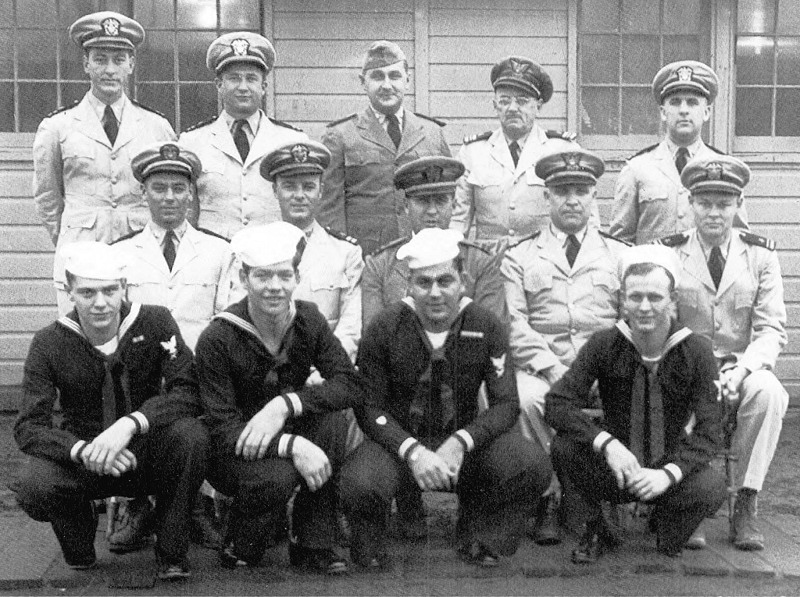
The
training staff, probably near the end of the program. Top row, left
to right: Lieutenant T. E. Fitzgerald, Lieutenant J. H. Brigleb,
Commander John J. Hutson, Jr., USCG, Lieutenant Commander George V.
Stepanoff, USCG, and Lieutenant F. A. Levy. Middle row, left to
right: Lieutenant Andrew Gagarin, Lieutenant T. L. Hickey, Lieutenant
F. D. Abbott, Lieutenant C. D. Chockluk, and Lieutenant (j.g.) W. P.
Moller, Jr. Bottom row, left to right: Y1c D. Reske, S1c C. W. Smith,
Y1c J. Kazanjian, and MoMM3c W. E. Smith. Several members were
missing when this photograph was taken.
Maxwell grasped the major difficulties immediately. Maxwell noted that “The Russian-speaking interpreters assigned, I believe, should be increased in number.” Moreover, he stressed the necessity of bringing the ships' equipment allowance lists up to date before their departures for the transfer point. "This point cannot be too strongly emphasized, as it is understood that the foreign power is very particular in this respect. This will greatly assist in expediting the transfer." The program eventually followed Maxwell's outline.
Maxwell, newly promoted to captain, arrived at Cold Bay on 19 March and assumed command of the base the next day. Contrary to what he had learned in Washington, the base needed considerable work before it could receive Soviet trainees. In view of the large housing and messing facilities required, Maxwell agreed to move his command into the Army's quarters at Fort Randall, which could accommodate 10,000 men. Most of the problems that arose concerned reconstituting essential services. For example, with the decommissioning of the base in November 1944, the medical stores and the lone ambulance had been transferred to Kodiak. A fire inspector from Kodiak also pointed out numerous deficiencies in many of the buildings.
Moreover, the miserable weather (over 40 inches of rain annually, heavy fog, and 16 cloudy days each month) and poor physical layout of the facilities (buildings lay situated, Maxwell said, "in typical Army fashion" across seven miles of mud, connected by gravel roads) slowed the rehabilitation effort. Maxwell feared these problems would also slow down the daily training routine if not corrected. Fortunately, a Construction Battalion (CB) unit hauled Quonset huts into the training area "in record time," and set up classrooms. A radio station, several crude movie theaters, and a "small, very muddy Softball field" dubbed Yankee Stadium provided a bare modicum of luxury and recreation.
An advance party, led by then-Lieutenant Commander John J. Hutson, USCG, had established the Antisubmarine Warfare (ASW) Department prior to Maxwell's arrival. The captain quickly selected instructors for radio, radar, engineering, gunnery, mine sweeping, damage control, and landing craft training duties. In addition to personnel provided by Fletcher, Maxwell used the officers from the ships being transferred. Members of the Liaison Department, who coordinated project business with the Soviet contingent at Cold Bay, often performed double duty as trainers.
William Stewart Maxwell (1900-1989)Contemporaries likened Maxwell to the popular characters found in Horatio Alger's rags to riches novels. He was born in Warsaw in 1900, when Poland was part of the Russian Empire, with a surname of Dzwoniecki. At approximately age 13, he entered the German navy or merchant marine (the record is unclear) only to jump ship, arriving in New York City alone and unable to speak English. The youth came to the attention of George Maxwell, a recruiter for the U.S. Navy who formally adopted him, gave him a new name, and in 1916 helped him enlist in the Navy. Except for a few months spent in professional boxing in 1920, Maxwell stayed in the service for some 33 years and advanced in rank from apprentice seaman to rear admiral. Maxwell thrived on the opportunities within the Navy for self-development, particularly in education and leadership, and advanced rapidly through the ranks. In 1923, he made warrant machinist, and received an ensigns commission four years later. Maxwell overcame a penchant for hazardous duty—he was an experienced submariner and had once requested flight training in dirigibles—to concentrate on engineering assignments, perhaps out of regard for his wife, Ethyl, and children, William Jr., Colleen, and Robert. During his career, he held engineering billets on board four battleships. While engineering officer and later executive officer of Lamberton (DD 119) in the 1930s, he received a commendation from BUSHIPS for designing high-speed minesweeping gear. Maxwell preferred engineering duty. Indeed, he excelled in it. Time and again, however, he received special assignments because of his Russian language skills. Maxwell never claimed to have more than average ability in the language; a junior officer, university-trained in Russian, who observed him in Alaska in 1945, said Maxwell spoke "a most peculiar Russian, a combination of Polish, Russian and Byelorussian." Nonetheless, prior to his assignment to Cold Bay, Maxwell served as an interpreter with landing parties sent from the old Brooklyn (Armored Cruiser No. 3) into Siberia during the American intervention in the Russian Revolution in 1918; as a member of the Aleutian Islands Survey Expedition in 1933; and as a counterespionage agent working with the Federal Bureau of Investigation and the Office of Naval Intelligence to crack a Soviet spy operation in Los Angeles in 1938-1939.
Captain William Stewart Maxwell, USN, circa 1946. Sailors often remember one ship with greater affection than the others in which they served. Maxwell always felt a special attachment to the battleship North Carolina (BB 55). During several years as ship s engineering superintendent, he supervised her construction and fitting out. When the ship was commissioned in April 1941, he became her assistant engineering officer. In the waters around Guadalcanal in August 1942, when the battleship went into combat for the first time, he served as the engineering officer, with his eldest son, William Jr., an enlisted shipmate. While he was on board North Carolina, Maxwell earned several of the combat awards on which the Navy later based his advancement to rear admiral at retirement. In fact, Maxwell received much of the credit for the battleship s exceptional performance in the Battle of the Eastern Solomons on 24 August. Since the summer of 1941, North Carolina had followed a demanding schedule in the Atlantic Ocean with little opportunity to perform essential repairs and upkeep. The operational tempo only increased with her transfer to the Pacific in June 1942. In late July she formed part of the screening force for the carrier Enterprise (CV 6) in Operation WATCHTOWER, the seizure of Tulagi and Guadalcanal scheduled to begin on 7 August. Because North Carolina's best speed (27 knots) could not match that of the carrier and the other escorts, the battleship operated at full power 75 percent of the time and spent the other 25 percent in preparation to go to full power on short notice. As a result, the ships complement had to effect engineering repairs, such as those required by the boilers, without slowing the ship. In late August, operating near the Solomon Islands, North Carolina became the first of the new fast battleships to escort a carrier in battle. In the battle of 24 August, Japanese carrier aircraft concentrated on Enterprise and North Carolina, requiring both ships to maneuver radically at maximum speed to evade bombs and torpedoes. Although the enemy planes made seven near misses, they scored no hits on North Carolina during an eight minute attack. The only casualty was one man, killed by a strafer. The battleship claimed seven enemy aircraft shot down and a hand in destroying seven others. In his action report, Captain George H. Fort, North Carolina's commanding officer, singled out Maxwell and the gunnery officer for special recognition. To keep the battleship operating at high speed, which included the maximum 27 knots at the height of the engagement, Maxwell donned an asbestos suit, entered the firebox of a recently secured boiler, and, exposed to the intense heat, personally directed emergency boiler repairs. He entered heated boilers four times during the operation, for which he received a bronze star for heroism. Maxwell remained on board North Carolina until 1943. In 1944, he helped place the new battleship Missouri (BB 63) into commission and, in December, took over the BUSHIPS' engineering desk for battleships. Maxwell had occupied that billet for only two months when he received the HULA assignment. In 1946, he served as officer in charge of the BUSHIPS' machinery unit during the atomic tests of Operation CROSSROADS. Ironically, the only duty connected with the Russians he ever sought—his application for duty as naval attache in Moscow—was rejected. In his final assignment, he served as assistant naval attache for petroleum in Egypt. Upon retirement for medical reasons in 1949, Maxwell advanced in rank to rear admiral on the basis of his combat awards. During his Navy career Maxwell earned a reputation as a friend of the enlisted man. "[He] reminds you of one of the friendly bears in a Walt Disney cartoon," wrote a yeoman at Cold Bay. "The Captain is gruff, constantly growls jokingly at his subordinates, . . . calls his orderly, Marine Corporal Randall Booth, of Cincinnati, Ohio, 'General,' and enjoys nothing more than a good joke." Maxwell's son Robert, who graduated from the Naval Academy in 1949 and spent a midshipman's summer cruise on board North Carolina, recalled the grand treatment he received from chiefs still on board the battleship who remembered his father fondly. Maxwell held city and state government posts in New York throughout the 1950s. As deputy director of the Smoke Control Bureau of New York City, he proved incorruptible in his aggressive and highly controversial pursuit of polluters. In 1955, New York Governor W. Averell Harriman appointed him chairman of the Board of Standards and Appeals in the State Labor Department, a position which he held for six years. In 1961, Rear Admiral Maxwell took "command" of North Carolina, which the state of North Carolina had acquired, to help turn her into a museum ship. In retirement, Maxwell shied away from public view. He rejected attempts to involve him as a candidate in party politics and shunned the attention of journalists who expressed more than a superficial interest in his life story. Moreover, he turned a deaf ear to the suggestion that he write an autobiography and rejected a filmmakers desire to produce a movie about him. He left neither personal papers nor an oral history. To the end, even Maxwell's family found the admiral reticent to discuss his life and career. He died on 10 July 1989 and lies buried in Arlington National Cemetery beside his adoptive parents. |
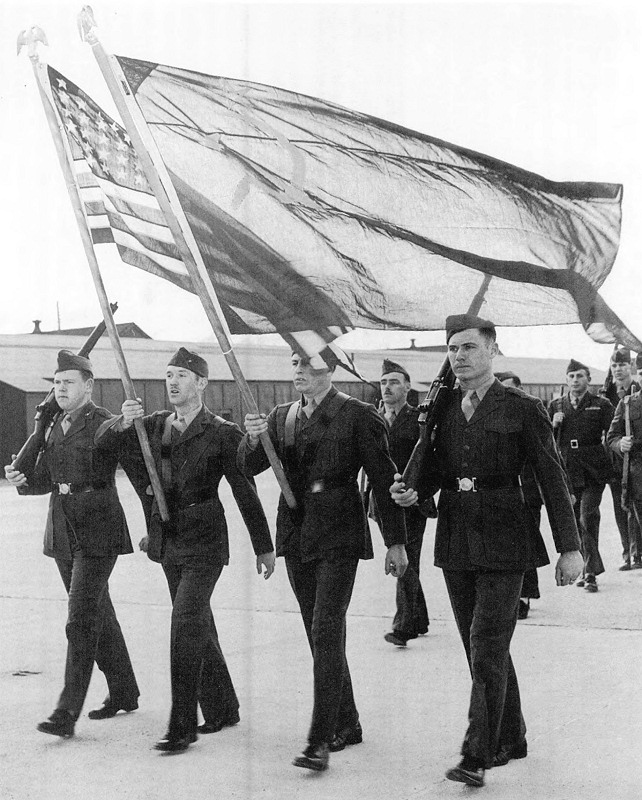
U.S.
Marine Corps honor guard marches with the national colors of the
United States and the Soviet Union during ceremonies welcoming Rear
Admiral Boris D. Popov to Dutch Harbor, April 1945.
Maxwell and Hutson, who was both training officer and second in command, worked tirelessly to gather the necessary radios, radars, minesweeping gear, gyrocompasses, engines, movie projectors, training films and various educational tools. Because the ships would have only short shakedown periods, such items proved invaluable.
Striking the proper balance between time spent ashore and time spent on board ship became an early bone of contention between the American and Russian training staffs. Maxwell believed that thorough classroom training on equipment and procedures would prevent later shipboard casualties among the Soviet crews and damage to the vessels. But representatives of the Soviet Purchasing Commission, led by Captain 1st Rank Nikitin, who arrived on 23 March, took a different view. They felt that too much time would be spent on shore-based training. To reach an accommodation, both sides conferred day and night over the next week designing a program for the first training cycle. These conferences, presided over by Hutson, finally produced an acceptable plan, which served as a model for all training cycles.
Boris Dmitrievich Popov (1908-1984)
Popov was born in 1908 to a family of teachers at Derevyansk, a little village by the Vychegda River, some 170 miles east of the Ural Mountains in northern Russia. He completed his secondary education and entered the prestigious Frunze Higher Naval School in Leningrad in 1926. Upon his graduation in 1930, Popov joined the crew of the old dispatch boat Vorovskii in the Amur Flotilla. While serving in the Pacific Ocean Fleet (formally established in January 1935), Popov served as navigator, executive officer, and commanding officer in escort ships and destroyers, as the chief of staff of a destroyer brigade, that same brigade's commander, and as a fleet staff officer. In November 1944, at age 36, he became a rear admiral. In 1945, Popov commanded the Fifth Independent Detachment of Soviet Navy Ships at Cold Bay, Alaska. Americans found the admiral nervous and careworn in appearance, but likeable, easygoing and an ardent fan of American movies. Captain Maxwell attributed Project HULA's success, in part, to Popov's friendly and cooperative attitude. After the war, Popov served on the staffs of the Pacific Ocean Fleet, naval headquarters in Moscow, and the Northern Fleet. He also held a seagoing command in the Black Sea Fleet. In November 1949, the navy transferred Popov from active duty to the reserves for medical reasons. Among his numerous awards and medals, he received two Orders of the Red Banner and the medals for victories over Germany and Japan. Popov retired to Odessa, where he died on 2 June 1984. |
Beginning on 10 April, a Soviet merchant ship carrying nearly 500 men arrived at Cold Bay each day for five days. Rear Admiral Boris D. Popov, commander of the 5th Independent Detachment of Soviet Navy Ships, the official unit designation of the Soviet naval contingent at Cold Bay, arrived in Sevastopol on 11 April. By 14 April, 2,358 men had disembarked. These trainees comprised the prospective crews for the 16th Mine Sweeper Division (twelve Admirable-dass and six YMS-type ships) and the 2nd Subchaser Division (twenty vessels). They joined almost 1,350 American personnel already present at Fort Randall/Cold Bay. At this early stage, Maxwell had on hand 49 officers and 317 Navy enlisted men, 6 officers and 322 enlisted Seabees, 2 officers and 45 enlisted men of the Marine Detachment, and 39 officers and 566 enlisted men from the Army. While the number of Americans at Cold Bay remained rather constant at about 1,500, over time the number of naval personnel was increased and the Army personnel were transferred out.
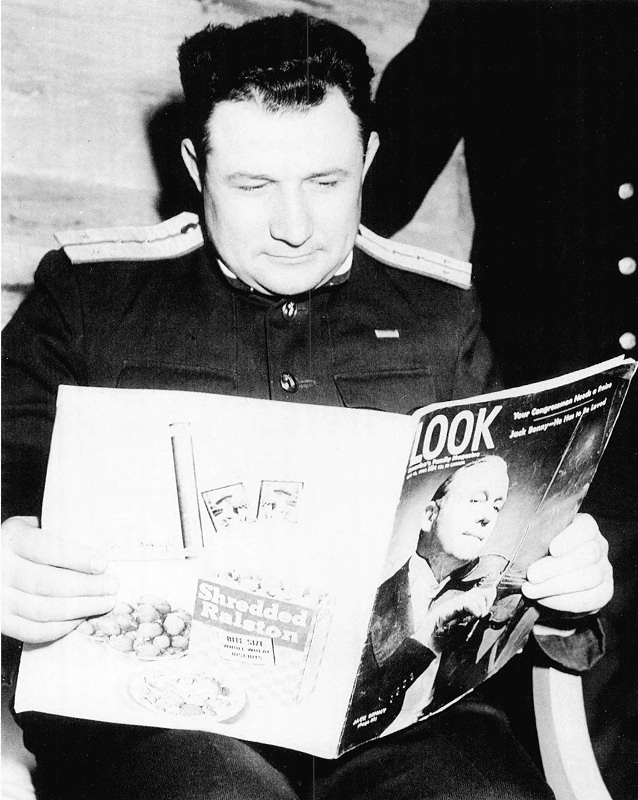
A
Soviet naval officer relaxes with Look magazine.
Apart from the suspected intelligence officers, U.S. naval officers
reported that many of their counterparts knew some English.
Training began on 16 April. The final reports of both Maxwell and Popov each reflected the difficulties experienced by the first Soviet training group. The 220 officers and 1,895 men who began the first shore-based training program knew almost nothing about radar and sonar, and very little about working the engineering plants. Popov recognized that his sailors needed intensive training and that even his specialists had to familiarize themselves quickly in the use of the "new apparatus" on board these American warships. Maxwell observed that the lack of Russian-language training materials, especially for "the use and operation of mechanisms and apparatus found on the ships," slowed the process. The 5th Detachment staff and representatives from the Soviet Purchasing Commission, all of whom proved extremely cooperative with the American staff, eventually produced their own Russian-language manuals.
Maxwell divided Soviet personnel by ship types and then by prospective crews for individual ships in the training program.
American instructors identified a nucleus of sailors in each crew familiar with basic ship handling, but even these men required instruction with regard to the special characteristics of their ship type. "From the seriousness with which the visiting crews are taking this training it appears that they are most interested and sincere in learning all they can," Maxwell reported. As the program progressed, outstanding Russian personnel—trained by their American counterparts—served as instructors.
Before leaving Washington for Alaska, Maxwell had pointed out the need to reconcile all equipment allowances before the ships for HULA arrived at Cold Bay. BUSHIPS did not heed this early warning, and delays installing or removing equipment from the transfer vessels disrupted the initial schedule. Six minesweepers, for example, arrived at Cold Bay outfitted with electronic equipment that was not authorized for transfer to the Soviet navy, while in some vessels shipyard technicians had removed authorized equipment. "All transfer vessels have from 200 to 900 shortage items each," Maxwell reported to Fletcher. BUSHIPS flew in thousands of pounds of equipment (such as combat helmets) daily, while their on-site representatives helped ameliorate these unfortunate circumstances by exercising their authority to revise the equipment lists.
Delays in training caused by ship damage became another issue. Once the program got under way, the wooden-hulled vessels, such as the motor minesweepers and subchasers, frequently suffered hull damage from the rough seas. Yet, only the facilities at Dutch Harbor could perform adequate repair work. Nine subchasers and one motor minesweeper made the nearly 400-mile round trip to Dutch Harbor for major repairs; the subchaser program was delayed by eight days.
The most efficient training program conducted at Cold Bay concerned the transfer of thirty large infantry landing craft in two training cycles. Training for the first fifteen-ship LCI(L) group began on 7 May and lasted 15 days. In addition to the officers, American enlisted men from each craft served as instructors. During this phase, HULA instructors trained 100 Soviet naval officers and 800 enlisted men in general ship operation and amphibious warfare, particularly attack formations and beaching. Based on the experience in the first phase, the shakedown period for the second group of landing craft was cut to nine days. These sailors completed their training one week ahead of schedule and headed home at the end of July 1945.
Landing Craft, Infantry (Large)Navy planners recognized that the procedure of disembarking assault troops from transports lying offshore and landing them on an invasion beach in small davit-carried craft would often prove impractical. As a result, the Navy procured a variety of landing craft and amphibious ship types during the war. The LCI(L) filled the specific need for a seagoing troop carrier capable of moving a large number of troops directly from a staging area to a hostile shore.
The LCI(L)s transferred at Cold Bay measured 159 feet in length and 23 feet, 8 inches at the beam. They displaced 387 tons (full load). Diesel engines and twin propellers drove the LCI(L) at 12 knots with a cruising radius of some 8,000 nautical miles. The main armament consisted of five 20mm antiaircraft machine guns. In addition to a crew of 8 officers and 32 enlisted, the LCI(L) could accommodate 188 men and sustain them for about 48 hours. As a cargo carrier, it could haul 75 tons. Navy planners didn't envision the LCI(L) undertaking long voyages. The initial concept for the vessel's use actually called for its construction in sections and assembly in a forward area. This process, in fact, proved unnecessary. The landing craft far exceeded expectations for seaworthiness and durability. During extensive service in Europe and the Pacific, this type performed a multitude of combat tasks well. Indeed, by 1944 the Navy had converted more than 200 LCI(L)s into a gunboat version equipped to provide close-in fire support during amphibious landings. The Navy built some 1,100 LCI(L) variants during the war. In addition to the U.S. and Soviet navies, American-built LCI(L)s saw wartime service in the British Royal Navy. |
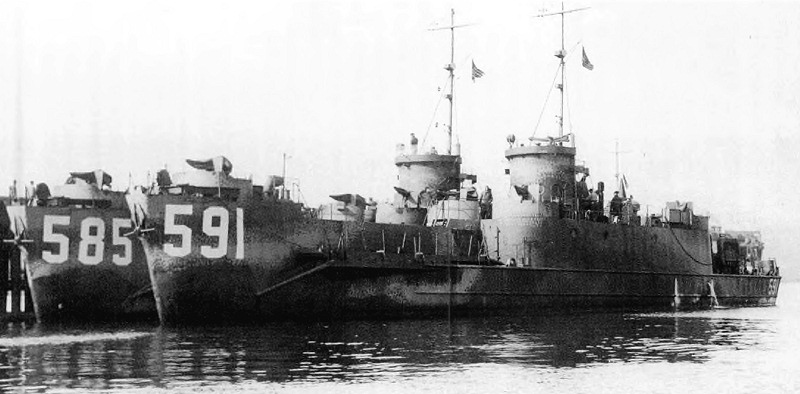
Wearing
camouflage, LCI(L)s 585 and 591 await
transfer to the Soviet navy at Cold Bay in spring 1945. As DS-45
and DS-35, respectively, they took
part in Soviet operations against Japanese forces in northern Korea.
The Soviet navy returned LCI(L) 585 to the U.S.
Navy in 1955. DS-35 was scrapped.

Below,
Admiral Popov cuts a cake decorated in his honor on Memorial Day,
1945. Receptions, parties, and holiday military parades, which often
took place at Dutch Harbor, provided a respite from the rigorous
training schedule kept at Cold Bay. Lieutenant George Heiskanen, USN,
once a cadet in the Imperial Russian Navy, looks over Popov's
shoulder, as Captain Sylvius Gazze, Dutch Harbor's commander, and
Maxwell observe.

Popov
and his translator fishing.
In the meantime, the first three Cold Bay-to-Petropavlovsk convoys had sailed, on 28 May (three minesweepers and five motor minesweepers), 30 May (three minesweepers and six subchasers, with one dropping out for repairs at Adak), and 7 June (three minesweepers and seven subchasers), all under U.S. Navy escort. The routing plan called for vessels such as the subchasers that could not make a non-stop passage to Petropavlovsk to proceed through Unimak Pass and coastwise along the northern side of the Aleutian Chain to Adak for servicing. Northwest of Attu the U.S. Navy escort departed, and the convoy proceeded independently north of the Komandorskii Islands to pick up their Soviet escorts for the final leg to the Petropavlovsk Naval Base. A fourth convoy, comprising two minesweepers, six subchasers, and four LCI(L)s, departed Cold Bay on 11 June.

On
20 May 1945, in foreboding weather, Soviet and American sailors of
this Admirable-class minesweeper stood by as
Rear Admiral Popov addressed them during the transfer ceremony.
In terms of size, armament and financial investment, the Tacoma (PF 3)-class frigates represented the most valuable vessels transferred at Cold Bay. Each ship measured 304 feet in length, displaced 2,100 tons, and possessed a design speed of approximately 20 knots. In most cases, they mounted three 3-inch dual purpose guns, two twin 40mm antiaircraft guns, and an assortment of ASW weapons.
The ships and men for the first frigate training program assembled at Cold Bay in mid-June. On 12 June, 572 officers and men for the 10th Frigate Division arrived at Cold Bay on board the steamer Felix Dzerzhinskii. They barely had time to get settled in before their shore-based training started. Classroom instruction for prospective commanding, executive, navigation and gunnery officers, as well as radiomen, began just two days later. That same day nine of the ten frigates scheduled for transfer during this cycle arrived from Kodiak after receiving overhauls in Seattle. On 15 June, the steamer Chaikovskii delivered 570 more men of the 10th Frigate Division.
Tacoma (PF 3)-Class FrigatesThis class owed its creation as much to the desperate need for convoy escorts as to the availability of building ways at shipyards on the Great Lakes. In 1942, the success of German U-boats in the war on Allied shipping and the lack of escort vessels to protect it persuaded President Roosevelt of the need to engage the shipbuilders under the jurisdiction of the Maritime Commission in the mass production of small warships. In response, the commission proposed to build a ship derived from the British River-class corvette. The latter had originated as a mercantile design and was being built in British shipyards accustomed to such work. The contracts would go to shipbuilders on the Great Lakes because they had similar expertise and their prewar contracts were nearing completion. Commission administrators believed that the uncomplicated design of the corvette and its proven operational utility would suit both the builders, who didnt have to alter their construction methods, and Navy officials, some of whom doubted the ability of these yards to produce a rugged combat ship. The prominent naval architecture firm of Gibbs & Cox modified the River-class corvette to satisfy American purposes. In November 1942, the Commission tasked its West Coast Regional Office with coordinating the corvette s construction between yards on the West Coast and the Great Lakes. Kaiser Cargo of Oakland, California, received a contract to prepare detailed ship s specifications and to manage procurement. On 8 December 1942, the Maritime Commission contracted for 69 ships. The Navy dropped the British term "corvette" in favor of the gunboat (PG) designation and named them after small cities. Kaiser Cargo received orders for twelve ships, and the Commission ordered 18 from the Consolidated Steel Company in Wilmington, California. Five Great Lakes shipyards involved in the program accounted for another 39. One Great Lakes firm, Ohio's American Shipbuilding Company, later added six more, making 75 in all. Walsh-Kaiser of Providence, Rhode Island, built 21 for Great Britain, which became the Colony class, bringing the grand total to 96 ships. The production of these vessels—redesignated as frigates (PF) in April 1943—immediately fell far behind schedule. Ironically, the centralization of all design, working procedures, and procurement functions under Kaiser Cargo sometimes failed to take into account the peculiarities of the Great Lakes yards, whose availability had spurred the frigate s creation in the first place. Prefabrication procedures devised in California, for example, had to be reworked to suit the smaller erecting cranes in use at the Great Lakes shipyards. In addition, winter and spring ice prevented frigates built on the Great Lakes from passing through the Sault St. Marie locks; consequently, the ships had to be floated on pontoons (to reduce their draft) down the Mississippi River for outfitting at either New Orleans, La., or Houston, Texas, which often doubled the time needed to finish them. As a result, only twelve entered service in 1943, by which time the Navy no longer considered them essential, and had passed responsibility for manning them to the U.S. Coast Guard. Vexed by a variety of production delays, shipyards responded to the pressure to complete frigates by delivering them, according to naval historian Samuel Eliot Morison, in "shockingly incomplete condition." As a result, shakedown cruises and post-shakedown availability, which in many cases took months to complete, insured that no frigate was ready for service before 1944. Kaiser-built ships (PFs 3-14) proved notorious in this regard. The Navy, for example, commissioned the class leader, Tacoma, in November 1943; however, the ship spent the next ten months correcting its many defects. While attributable in part to a shortage of skilled labor in the San Francisco Bay area, design defects such as bilge keels that tended to crack in rough seas and cold weather, failures in the welds connecting the deckhouse to the deck, and inadequate ventilation affected the entire class. Chronic problems with their triple-expansion reciprocating engines also impinged on readiness. Of the original 69 ships ordered, the Navy placed the last, Alexandria (PF 18), in commission only in March 1945. With their defects corrected, though, the frigates demonstrated good seakeeping qualities. All 18 frigates built by Consolidated Steel, which generally outperformed the rest of the class, escorted convoys and supported amphibious operations in the southwest Pacific with the Seventh Fleet. Rockford (PF 48) even teamed with the minesweeper Ardent (AM 340) to sink the Japanese submarine I-12 in November 1944. With a much larger number of the more effective destroyer types available and a diminishing Axis submarine threat, however, the Navy relegated the frigates to local escort, training, and weather patrol duty. By late 1944, the surplus of more capable escorts permitted the Navy to commit 30 frigates to Project HULA for delivery to the Soviet Pacific Fleet in the summer of 1945. Of the 28 turned over, the Soviet navy received 12 of the most reliable ships (those frigates built by Consolidated) and 7 of the least reliable ships (those built by Kaiser) of the class. Though the latter included Tacoma and the equally problem-plagued Pasco (PF 6), extensive yard work corrected their defects prior to delivery. In 1949, the Soviet government returned 27 frigates, reporting that the ex-USS Belfast (PF 35), which had nearly sunk in a storm off Petropavlovsk in 1948, was damaged beyond economical repair. The Navy reactivated thirteen of these ships for duty in the Korean War. Tacoma-class frigates later served in the navies of several foreign countries, including the Republic of Korea, Thailand, and Japan.
|
Following a material inspection by American and Soviet personnel, the Soviet crews boarded their ships.
The transfer of the frigate Coronado (PF 38) typified that of the other frigates. After a tour of duty in the southwest Pacific, Coronado put in at Boston, Massachusetts, on 24 January 1945. There, the ship received an overhaul of her main engines and boilers, incorporated numerous alterations and "changed the electrical equipment and armament to conform with the new allowance." This meant that equipment that had been installed only the previous month was removed. On 26-28 March, representatives of Commander, Destroyers, Atlantic Fleet, inspected Coronado, and “were most helpful in pointing out descrepancies [sic] and in helping iron out details.” Escort Division 25, comprising Long Beach (PF 34) (flagship), Ogden (PF 39), San Pedro (PF 37), Glendale (PF 36), Belfast (PF 35), and Coronado, got underway for Seattle via the Canal Zone on 28 March.
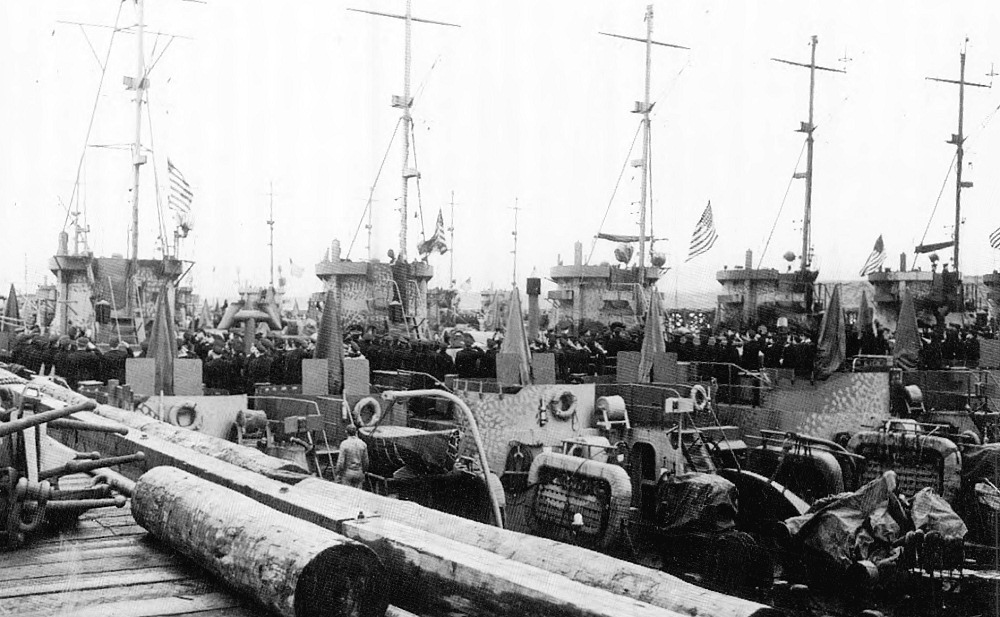
Lowering
of the American flag on board LCI(L)s, 9 June 1945. These craft took
part in operations against Japanese forces in northern Korea.
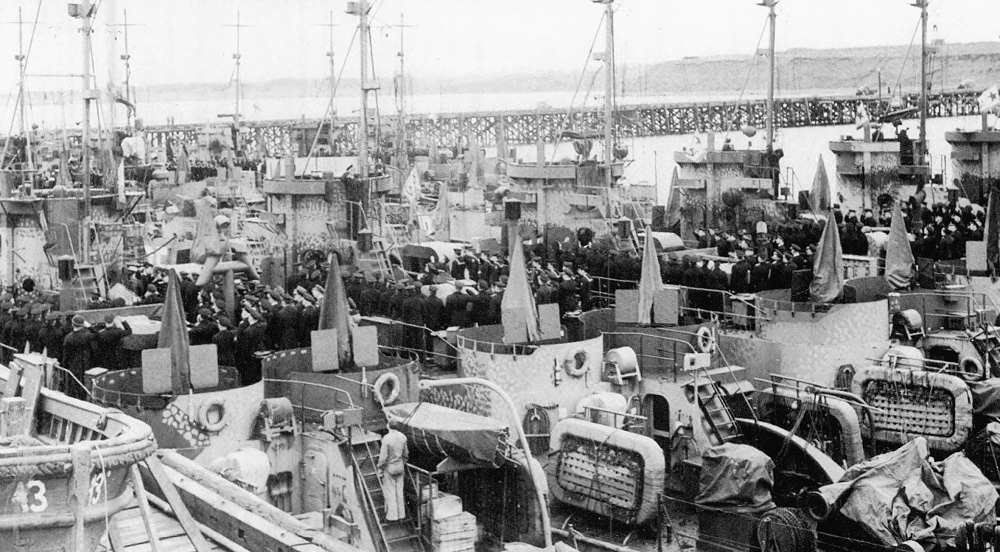
Another
view of the LCI(L) transfer ceremony on 9 June 1945. In this
photograph, sailors raise the Soviet naval ensign.
Coronado spent 30 April and the first sixteen days of May moored at the Lake Union Lumber Company Pier in Seattle, where contractors from the Pacific Electric Company completed post-voyage repairs and maintenance. Workers reinstalled the attack plotter and sonar range recorder, and painted the entire ship above the waterline. With repairs completed, attention again turned to the "arduous task of correcting new allowance list to conform with installed equipment. Inventories revealed much minor excess gear and also a large shortage of many items. Requisitioning and invoicing involved many hours of work and remained incomplete at the end of the month." During the last week of May and the first few days of June the ship ran tests, reloaded ammunition and depth charges, reconciled the allowance lists, and sent ashore all excess gear.
On 7 June, Escort Division 25 off-loaded smoke generators and got underway for Kodiak. Immediately Ogden had to break formation to return to Seattle because of a salt water leak in the fresh water tank. Four days later the five remaining frigates arrived at Women's Bay, Kodiak, where they fiieled. Charlottesville (PF 25), Allentown (PF 52), Machias (PF 53), and Sandusky (PF 54) subsequently joined them. On the afternoon of 13 June, the nine frigates got underway and proceeded in column by the inland route to Cold Bay. They arrived the next day and were turned over to Maxwell's jurisdiction.
Coronado had incrementally reduced her complement to make room for the Soviet crew. On 13 June, 43 American bluejackets transferred to the Naval Operating Base, Kodiak, for return to the Naval Receiving Station, Bremerton, Washington, for reassignment. On 16 June, the ship s doctor and two deck officers departed for the District Coast Guard Office of the 13th Naval District for further assignment. On 17 June, Coronado passed a material inspection and the next day 2 Soviet officers and 48 men, all engineering force, reported on board. On 25 June, the prospective commanding officer, 3 other officers and 45 sailors reported on board. By 1 July, the entire Soviet crew of 12 officers and 178 enlisted men had embarked. Simultaneously, most of the American crew, including the executive officer, departed, so that by 7 July a nucleus of only 4 officers and 44 enlisted men remained to decommission the ship.
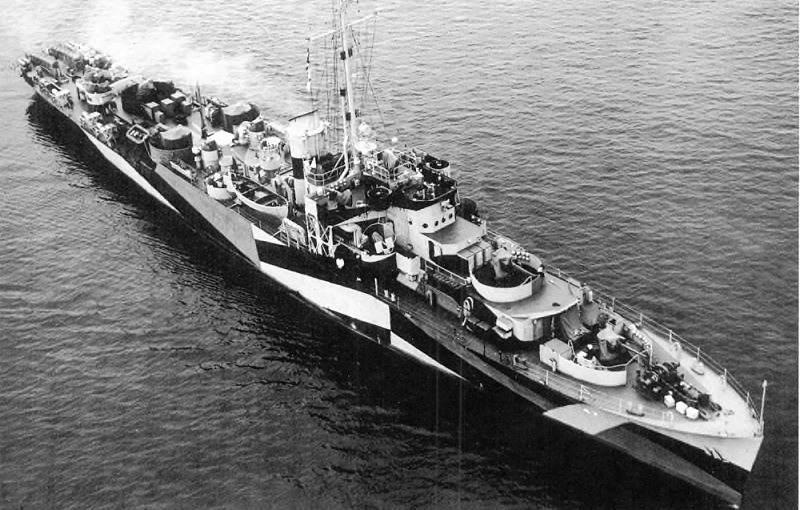
Gallup
(PF 47) wearing camouflage at San Pedro, Calif., on 30 May
1944. BUSHIPS conceived this scheme (which involved dull black, ocean
gray, light gray, and deck blue paint) specifically for the frigate.

Genuinely
amiable relations existed between the Soviet and American commands at
Cold Bay. In this photograph, Captain 3rd Rank Pavel A. Chicherin,
who had been injured in a automobile accident, presents Captain
Maxwell with an ornamental Soviet navy dagger at a transfer party,
held in the Russian mess hall, 9 June 1945.
Shipboard training began in earnest on 26 June, with Coronado getting underway two days later. That same day the Soviet sailors fired the ships guns by themselves for the first time. On 29 June, the American crew demonstrated fueling, towing at sea and use of the sonar equipment. The Soviet crew took total control of the ship the next day. Their ability to learn quickly the operation of the ship earned them high marks from their American counterparts.

Soviet
and American signalmen. In his final report, Maxwell wrote that "The
majority [of Soviet enlisted men] seemed at least as industrious as
the officers, learned their jobs quickly and thoroughly, and were
always easy to get along with; almost all [of them] appeared to like
and certainly to envy American personnel."
The American captain, E. H. Burt, characterized the training as "well started with an amazing amount of cooperation between the Russians and American crews. Language difficulties were partly offset by the fact the new crew was well trained and extremely interested in every detail of their assigned jobs." The Soviet crews most enjoyed firing the guns; on 8 July, Burt observed that they "demonstrated a marked skill for accurate firing."
American and Soviet crews trained every day, usually well into the evening, so that the task of training the prospective crews of ten frigates—approximately 2,000 officers and men—was completed as scheduled on 8 July. The men spent most of the next three days fueling the ships, taking on provisions, and otherwise preparing them for transfer to the Soviet navy.
The formal turnover ceremony took place on the afternoon of 12 July. As always, there was a good deal of excitement among both crews, as they would soon be headed home. While the specific details of Coronado's ceremony are not known, most transfers involved a Marine Corps honor guard and a Navy band playing "an inspiring medley of American and Russian melodies." At the appointed time, Maxwell and Popov and their subordinates took positions on board the ship, followed by the reading of transfer orders. A bugler played retreat, and American sailors hauled down the U.S. flag. All hands rendered a hand salute as Soviet colors were hoisted. The Soviet crew took over, and the American sailors marched off.
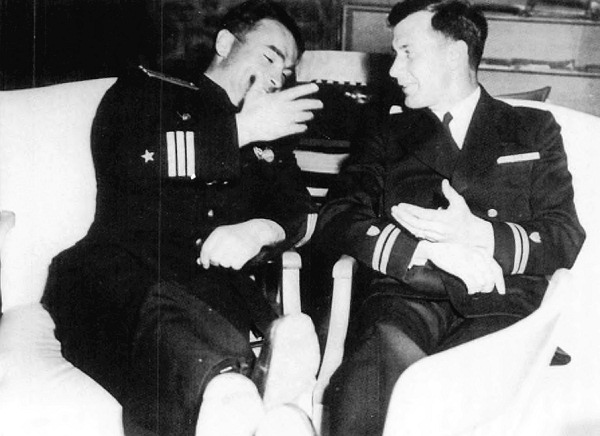
Captain
2nd Rank George Stepanyon, left, prospective commanding officer, and
Lieutenant E. H. Burt, Jr., USCGR, commanding officer of the frigate
Coronado, chatting at a party.
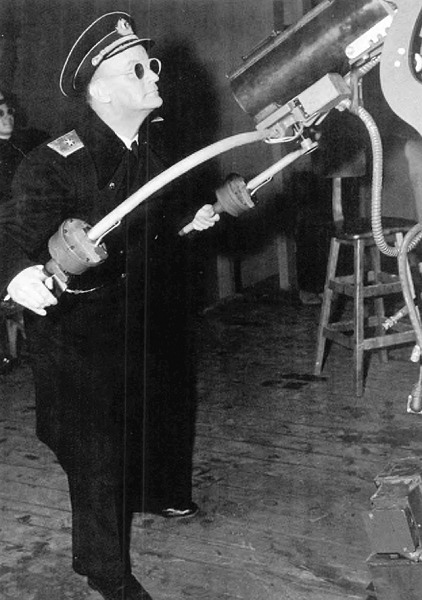
Right,
equipped with 3-D glasses, Rear Admiral Popov takes a turn on the
antiaircraft trainer at Naval Operating Base Adak, July 1945. Below,
Rear Admiral Popov tests his skill at pinball.
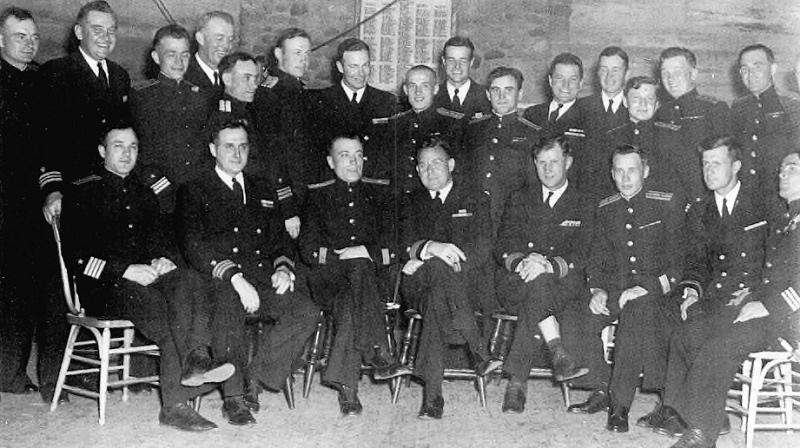
American
and Soviet commanding officers of the first ten frigates transferred
at Cold Bay. Commander John J. Hutson, Jr., USCG, the senior training
officer, is seated, second from the left. Lieutenant E. H. Burt,
USCGR, commanding Coronado (PF 38) is seated,
second from the right.

Starboard
view of the floating workshop YR 74, which was
identical to the four YRs transferred to the Soviet navy at Cold Bay
in 1945.
Under the Soviet naval ensign, Coronado became EK-8. Three days later, the first ten frigates stood out of Cold Bay, formed the sixth USSR-bound convoy, and set course for Petropavlovsk on the Kamchatka Peninsula.
In the meantime, HULA turned over three of the four floating workshops, which Soviet steamers took in tow on their way home to the Soviet Far East from the U.S. West Coast.
Maxwell's team also transferred a second increment of minesweepers ahead of schedule, so that by the end of July 100 vessels out of the original 180 were in Soviet hands.
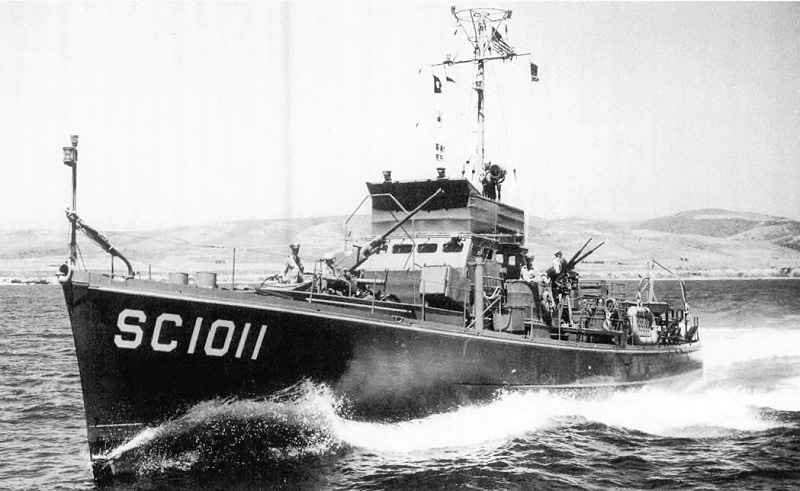
Commissioning
photograph of the submarine chaser SC 1011 underway
off Terminal Island, Calif., July 1943. Because of a shortage of 3723
cal. guns, the typical main battery, the builder, Fellows &
Stewart, mounted a 40mm Bofors machine gun. Single 20mm Oerlikons
also replaced the usual arrangement of two .50 cal. machine guns.
This craft carried the "Mousetrap" antisubmarine rocket
launcher forward and a pair of depth charge tracks on the stern.
The trouble-plagued subchaser program, however, threatened to upset the 1 October transfer deadline. Shoddy repair work and supply shortages in Seattle caused major difficulties. Maxwell was able to arrange for 13th Naval District, subchasers to substitute for the unsatisfactory vessels to keep the program on schedule. However, unbeknownst to Maxwell or Popov, momentous events in the Pacific War would soon create an even greater sense of urgency.
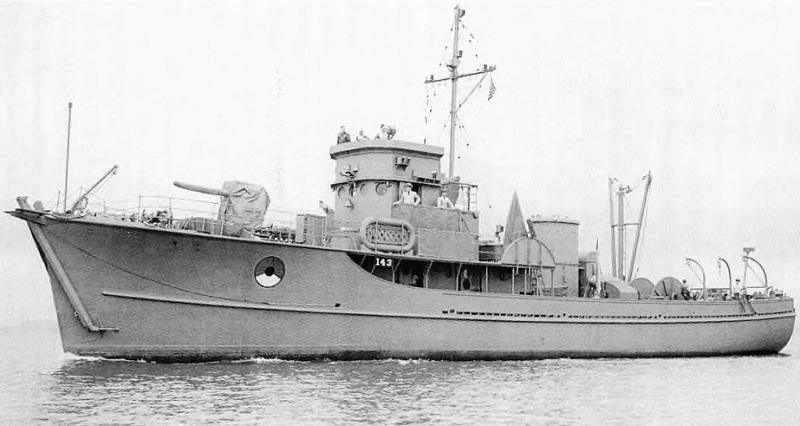
Builder's
photograph of motor minesweeper YMS 143, February
1943. As T-522, this ship saw action against
Japanese forces on southern Sakhalin Island, 11-25 August 1945.
Serving until July 1956, she was stricken from the Soviet navy list
and dismantled for spare parts. This type mounted a single 3750 cal.
gun and two 20mm machine guns, and could make 12 knots.
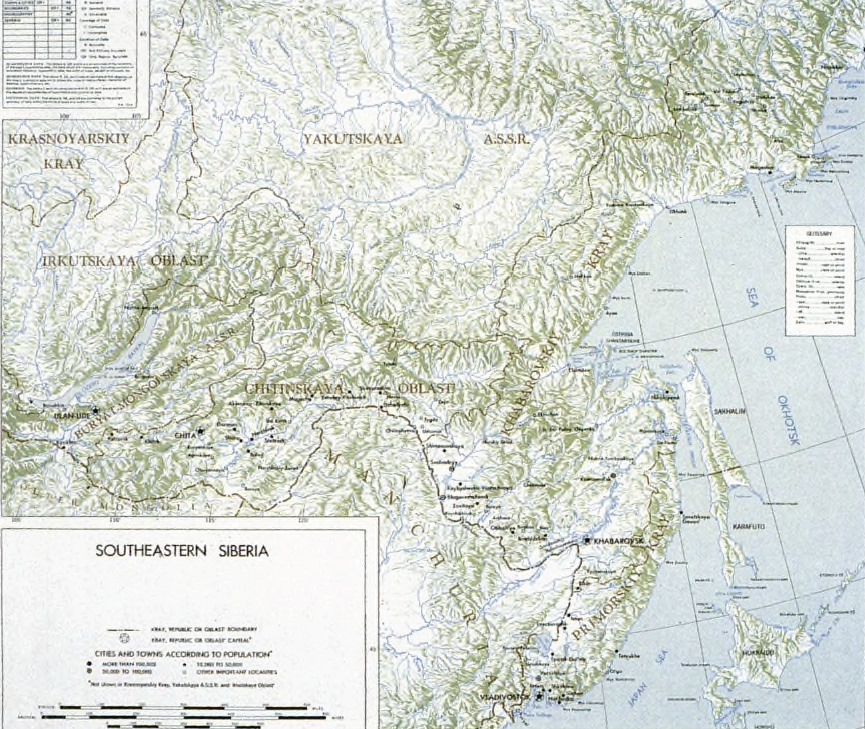
Southeastern
Siberia
At 1700 on 8 August (Moscow time), two days after the U.S. detonated the first atomic bomb over Japan and a day before the use of the second, Stalin made good his commitment to enter the Pacific War when Molotov informed Japanese ambassador Naotake Sato that a state of war would exist between their countries as of 0001 on the 9th. Within minutes of the time that war was declared, the Red Army launched a multi-pronged attack on Japanese forces in Manchuria. On 10 August, the government in Tokyo expressed a willingness to accept Allied surrender terms. On the 14th, Japan transmitted its acceptance of the terms. Anglo-American offensive operations, which had begun to wind down, halted altogether on 15 August. Fighting between Soviet and Japanese forces continued unabated.
The Soviet navy supported Soviet ground forces in operations against enemy outposts in southern Sakhalin Island, the Kuril Islands, and northern Korea. Joint army navy, and air operations against southern Sakhalin—Russia already possessing the northern half of the island—began on 11 August and lasted one week. Some 30,000 Japanese defenders put up a spirited fight. About 3,300 officers and men surrendered to Soviet forces in the northern areas on the 18th, but Japanese troops in the south resisted fiercely, fighting for a last chance at evacuation to Hokkaido.
On 15 August, Marshal A. M. Vasilevsky, Commander in Chief of the Soviet troops in the Far East, ordered the occupation of the northern Kuril Islands.
Attack on ShumshuOn the night of 15 August (14 August in Moscow) 1945, Marshal A. M. Vasilevsky, supreme commander of Soviet armed forces in the Far East, ordered General M. A. Purkayev, commander of the Red Army's Second Far Eastern Front and Admiral Ivan S. Yumashev, commander of the Pacific Ocean Fleet, to occupy the northern Kuril Islands of Shumshu and Paramushir. The responsibility for carrying out the occupation fell to the respective army and navy commanders on the Kamchatka Peninsula, Major General A. R. Gnechko of the Kamchatka Defense Zone and Captain 1st Rank Dmitri G. Ponomarev of the Petropavlovsk Naval Base. Gnechko, the overall commander, and Ponomarev faced formidable obstacles. Their orders required them to assemble an assault force from the units based on the peninsula and land it on Shumshu within 48 hours. The commanders estimated that keeping an assault force intact between the staging area at Petropavlovsk and the objective, a distance of some 170 miles in the worlds foggiest waters, and executing an attack at the correct hour would by itself be a considerable achievement if completed in 24 hours. That meant they had just 24 hours to organize their troops, orient them to the objective, and load them onto a motley collection of landing ships, transports, and self-propelled barges. Notwithstanding a 24-hour postponement which Gnechko requested and received, all troops, equipment, and supplies had been loaded by 1800 hours on 16 August. The landing force used the extra time to improve their interservice communications. Three hours later Ponomarev's 64 ships took up their assigned stations in Avacha Bay. Gnechko commanded a modest assault force of two reinforced rifle regiments and a naval infantry battalion, a total of 8,824 officers and men. He expected to encounter, according to Soviet intelligence, as many as 8,500 Japanese of the 91st Infantry Division on Shumshu, with as many as 15,000 reinforcements on nearby Paramushir. Intelligence estimates suggested that Japan s announced intention to surrender had left its ground forces in the Kuril Islands demoralized, small consolation given an enemy troop advantage of 3 to 1. Furthermore, the Japanese could call upon 77 tanks and the Soviets none. Even worse, the Russian advantage in artillery and mortars would be useless until the troops had established a beachhead. Poor weather limited Soviet aerial reconnaissance and ground support operations. The small size of Gnechko's assault force and the lack of heavy naval guns for fire support missions required a concentrated attack at one landing area. The minesweeper Okhotsk (3,200 tons), Ponomarev's largest ship, which mounted only three 130mm and two 76.2mm guns, provided fire support along with four 130mm guns on Cape Lopatka, just 12 kilometers from Shumshu across the First Kuril Strait, at the peninsula's southern tip. The ability of the force's small ships to keep station and to supply fire support while battling strong currents in the First Kuril Strait and enemy shore batteries on Shumshu remained in doubt. The operation began at 0500 hours on 17 August. Twenty-one hours later, the strike force entered the First Kuril Strait and took up positions off Capes Kokutan and Kotomari. The first wave, consisting of the naval infantry battalion of some 1,000 men, waded ashore at approximately 0430 hours on 18 August, completely surprising the Japanese. Even though Japanese resistance was disorganized, the attackers revealed their lack of tactical combat experience and amphibious training as small units made uncoordinated advances inland rather than securing the beach. Within the first hour, Japanese machine-gunners, well emplaced in pillboxes and foxholes, began to inflict heavy casualties. In addition, belated Soviet attempts to destroy enemy shore batteries met fierce resistance, and Japanese guns soon found the range of the ships offshore. As Gnechko feared, naval gunfire support proved ineffective, in part because of an almost total lack of radio communication with the troops ashore. As a result, enemy shore batteries wreaked havoc on the amphibious force when it approached at 0530. By 0900, this force, spearheaded by 16 American-built LCI(L)s recently acquired at Cold Bay, hastily unloaded the second wave, minus most of its radios and all of its artillery and mortars. Japanese shore batteries destroyed five of the vulnerable LCI(L)s.
At 0600 hours, units of the first wave tried to knock out the shore batteries on Cape Kokutan, but proved too few in number to breach the well defended heights. In fact, while pinned down on low ground, the Japanese counterattacked with infantry and 20 tanks. The attack failed to eradicate the naval infantrymen, who destroyed 15 tanks and charged up the heights, only to be repulsed just before reaching the top. At 0910, Soviet units on Shumshu finally established communications with the assault ships and Cape Lopatka. The latter's accurate fire flushed out the enemy, who counterattacked repeatedly. Although badly needing reinforcements and resupply, the naval infantrymen held out. The afternoon's good weather brought Soviet air support, and attacks on Paramushir's naval base halted the flow of Japanese reinforcements to Shumshu. Because of good coordination between the attackers, the support ships, and covering aircraft, the counterattacking Japanese suffered heavy losses. By the first night, Soviet forces (finally reinforced by artillery and mortars) held the western slopes of both major heights and a beachhead 4 kilometers long and 5-6 kilometers deep. In a series of night attacks, they wiped out most of the Japanese who defended the shore batteries. Gnechko planned to eliminate all Japanese resistance on Shumshu the next day. Heavy artillery came ashore on the morning of the 19th. Small pockets of Japanese, meanwhile, had already begun to surrender. At 0900, an envoy representing the 91st Division said that, according to orders from a higher command, Japanese forces would cease hostilities at 1600. The garrisons defending Shumshu, Paramushir and nearby Onekotan Island signed an unconditional surrender agreement at 1800 on the 19th, but sporadic fighting continued until 23 August, when the last Japanese finally gave up the fight. Soviet losses amounted to 1,567, including 516 killed. Japanese casualties numbered 1,018, the only instance in August 1945 when their losses fell below the Soviet total. With Shumshu and Paramushir secure, Soviet forces occupied the rest of the archipelago easily. |
He planned to occupy Shumshu and then Paramushir, the most heavily fortified islands and the two closest to Kamchatka, using the existing naval infantry and army units on Kamchatka. With these objectives secured, the lightly defended archipelago would fall.
With success on Sakhalin assured, Soviet planners turned their attention to Hokkaido. In late June, at a meeting on the military preparations of the Red Army in the Far East, the Politburo had discussed the subject of occupying Hokkaido. Nikita Khrushchev, a Politburo member since 1939 and wartime commissar with the rank of lieutenant-general, supported Marshal K. A. Meretskov's suggestion to occupy the island. Others, including Marshal Zhukov and Foreign Minister Molotov, opposed the idea.
The prospect of exposing the army to a fierce Japanese defense deterred some, while Molotov said such an act would be viewed as a blatant violation of the Yalta agreements. The Soviet General Staff and Navy General Staff, however, had already prepared estimates on the forces that would be required. Stalin seemed keen on the idea. Merchant ships had begun to embark troops and supplies for a landing on Hokkaido. Finally, on 22 August, Stalin halted further preparations.
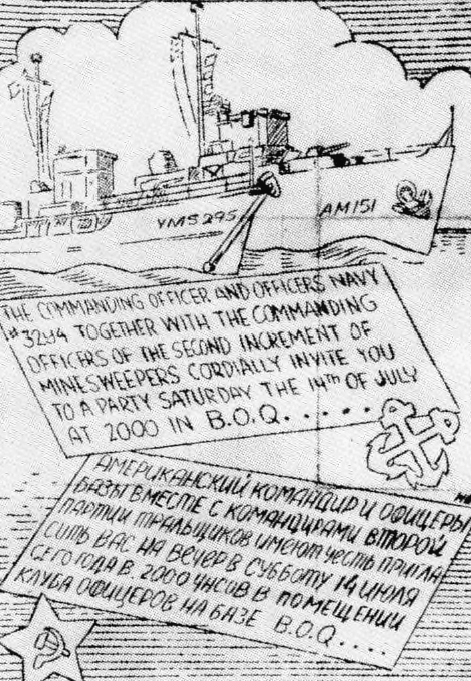
Senior
Lieutenant Aleksei K. Metelov, prospective Soviet commanding officer
of Augury (AM 149), received this invitation to
a party for 14 July. A month later, his vessel, designated T-334,
would be Major General A. R. Gnechko's headquarters ship
for the Kuril Island operation.

Metelov
and Lieutenant Commander J. E. Stonington, CO of Augury.

Fifty
years later, Metelov traveled to the Kuril Islands to participate in
a commemorative reenactment of the attack on Shumshu Island.
Meanwhile, in Alaska, training of Soviet navy crews continued. According to Maxwell, when the Soviet contingent received the news that the Soviet Union had finally joined the war, they seemed genuinely pleased with their new status as allies of America. Reporters rushed to register stories on the operation, wrongly assuming that with Soviet entry into the war the tight veil of censorship would be lifted.
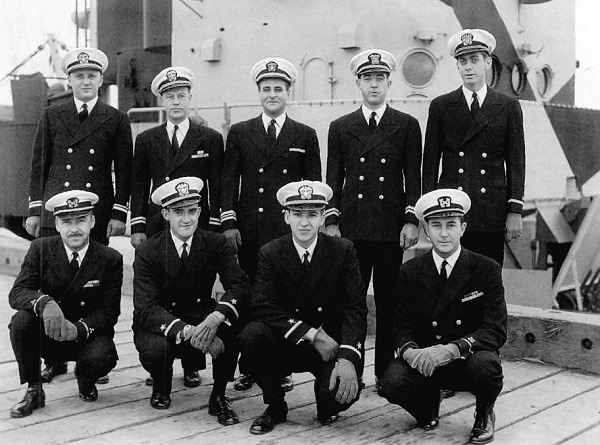
Photograph
of American officers of Augury (AM
149) presented to Senior Lieutenant Aleksei K. Metelov
as a memento.
Neither the Soviet Unions active belligerence nor news of Japans intention to comply with the Allied surrender demand affected the program, Maxwell reported, "except to give a most agreeable tone to our relations with the visitors, and to make us work harder than ever." Indeed, the Soviet-American team at Cold Bay accelerated its efforts to transfer the remaining vessels.
In the difficult period of transition from belligerency to occupying power, it would be only natural for the Soviets to request that Maxwell turn over as many vessels as possible until Japan was finally subdued. In late August and early September, Maxwell limited training to the minimum needed by the Soviet crews to navigate their ships home. Navy Detachment 3294 completed the final shore-based training of 3,700 Soviet officers and enlisted men on 25 August, raising the total of Soviet naval personnel trained at Cold Bay to 12,000, including some 750 officers. The effort to transfer as many ships as possible was aided by the Soviet navy, which returned sailors previously trained at Cold Bay to serve as nucleus crews for the remaining vessels.
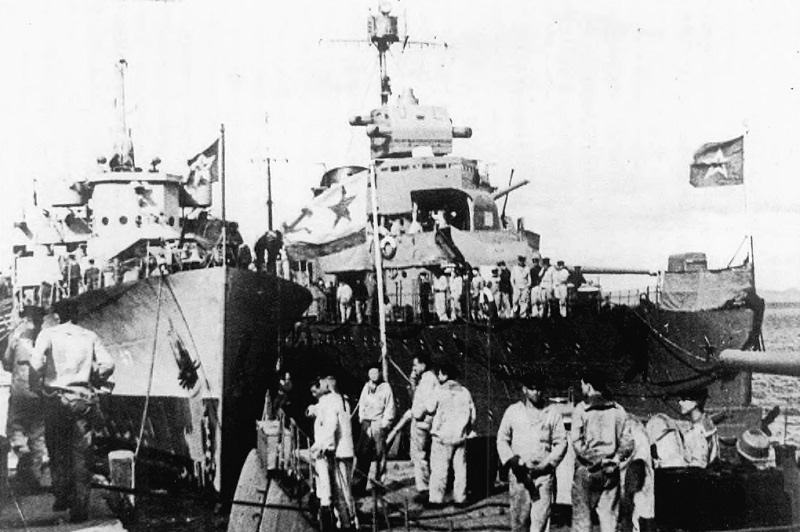
EK-22,
the ex-Gallup (PF 47), inboard of the
Soviet Type 7 destroyer Razyashchy, probably at
Petropavlovsk. The American-built ship arrived at Petropavlovsk on 5
September 1945, too late to participate in operations against Japan.
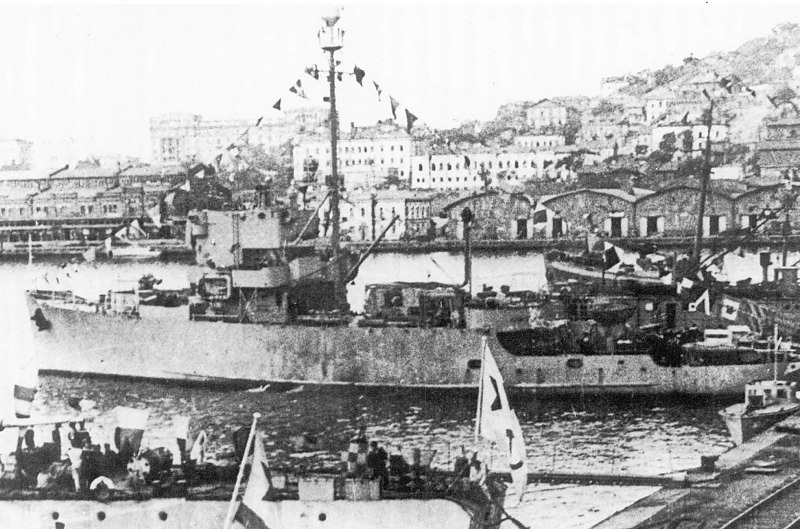
Soviet
minesweeper T-275, the ex-USS Measure
(AM 263), at Vladivostok in 1945, following operations
against Japanese forces in northern Korea. This ship served in the
navy and later with the fishing fleet, and was scrapped in 1960.
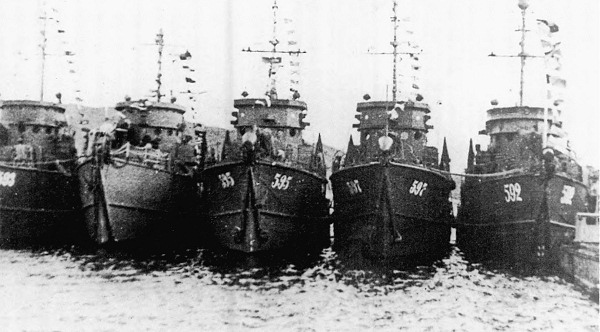
Veteran
motor minesweepers of the Soviet Pacific Fleet's operations against
Japan celebrate the end of the war, probably in Avacha Bay,
Petropavlovsk. Under Soviet colors, the wooden-hulled YMSs performed
a variety of combat, auxiliary, and scientific tasks. But they had
short service lives, and all were decommissioned by the mid-1950s.
In late August, Popov informed Maxwell that LCI(L)s trained by Navy Detachment 3294 in July had led the main attack in the Kuril Islands, just ten days after their arrival at Petropavlovsk. He didn't mention the losses. Other Hula ships, he said, participated in operations against enemy positions in northern Korea and on Sakhalin Island.
Soviet crews accepted two frigates on 2 September, the day of the Japanese surrender ceremony on board the battleship Missouri in Tokyo Bay, and four more on 4 September. On the next day, Soviet forces completed the occupation of the southern Kuril Islands, including the islands known as the Northern Territories. Hours later Maxwell received this information dispatch:
ABSOLUTE STOP ON LEND LEASE DELIVERY ARMS AMMUNITION AND SHIPS HAS BEEN DIRECTED INCIDENT TO SURRENDER OF JAPAN X UPON RECEIPT OF THIS DESPATCH CEASE FURTHER DELIVERY OF VESSELS UNDER HULA AGREEMENT X IN CASES WHERE RUSSIANS HAVE TAKEN DELIVERY COMMA VESSELS INCLUDING THEIR ARMS AND AMMUNITION MAY DEPART AFTER APPROPRIATE PERIOD TO GET READY X RATIONS AND SERVICES FOR PERSONNEL INCLUDING THOSE NOT YET ASSIGNED TO VESSELS AND THEIR TRAINING MAY CONTINUE UNDER LEND-LEASE UNTIL FURTHER ORDERS.
As a result, the four frigates transferred on 4 September remained at Cold Bay for additional training and shakedown until 17 September, when they finally departed for Petropavlovsk. Several vessels already en route to Cold Bay returned to Seattle. The two remaining frigates, Annapolis (PF 15) and Bangor (PF 16), arrived at Cold Bay after the program had ended, but were used to transport American personnel from Cold Bay to Seattle. Admiral Popov and his staff departed on 27 September on board the steamer Carl Schurz, along with the partially trained crews for the 2 frigates, 5 motor minesweepers, and 24 subchasers. Shortly thereafter Maxwell closed his books, disposed of equipment and began to ship his men home. He decommissioned the base at the end of the month. In 142 days, Navy Detachment 3294 had transferred 149 ships to the Soviet navy.
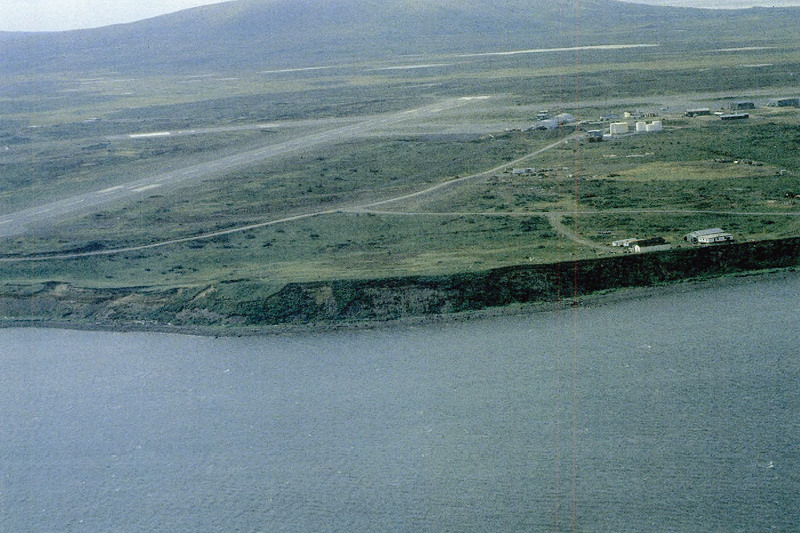
A
recent photograph of Cold Bay. In addition to several buildings, a
few gun positions and barbed-wire entanglements on the cliffs above
the beaches serve to remind the rare visitor to Cold Bay of its
status as a wartime outpost of the Army and Navy.
Project HULA satisfied President Roosevelt's enduring objective to link American and Soviet interests in the North Pacific in opposition to Japan. In late 1944, when the United States agreed to provide the Soviet Union with small combatants, aircraft, equipment, and other lend-lease goods in preparation for its intervention in the Pacific War, the U.S. Navy viewed the arrangement favorably. In the midst of a German winter offensive in the Ardennes, and with epic battles such as Iwo Jima and Okinawa still to fight, planners didn't foresee a swift end to the global war. Some nine months later, however, with Germany defeated, the combined impact of the atomic attacks and the Red Army s massive campaign in
Manchuria delivered the coup de grace to Japan. The cancellation of plans to invade Japan rendered the original concept of Soviet naval operations against Japan obsolete. Project HULA became superfluous.
The lend-lease operation at Cold Bay succeeded in spite of the language barrier, the constant impediment of bad weather, and the poor condition of many of the prospective transfer vessels. In this respect Project HULA stands as a rare example of successful Soviet-American collaboration. Maxwell believed that activities such as HULA "would be exceptionally valuable to each country in its understanding of the other, and that cooperation and kindness of the type which this Command attempted to offer would be instrumental in effecting the eventual conformity of their interests with our own, and in convincing the visitors that the development of such interests can best be implemented by forthrightness and honesty."
Despite the success of the Cold Bay training mission and Maxwell's hopes for Russian-American understanding, Project HULA proved to be the end rather than the beginning of Soviet-American military cooperation. Less than a year after the end of the project, the former allies had become bitter antagonists.
As of 20 December 1945, 3,741 American lend-lease ships were in foreign hands, including 585 combatants, 121 merchantmen, and 29 small watercraft in Soviet possession. United States law required the return of all vessels to American custody after the end of the war. The Navy Department hoped to avoid the high financial and manpower costs associated with return and disposal of the unwanted vessels, preferring to sell them as surplus property, requiring only their "constructive recovery," an administrative maneuver that precluded their actual return to American hands.
The disposal of lend-lease naval accounts occurred in the context of comprehensive settlement of obligations. Allied countries settled their accounts through routine diplomatic procedures. By February 1947, the United Kingdom, France, India, Belgium, Australia, New Zealand and Turkey had squared their ledgers with the United States.
The United States government first raised the issue of settling the Soviet obligation in February 1946. In a reply to a request from the Soviet Purchasing Commission for an Export-Import Bank Credit of $ 1 billion, the State Department linked approval of the credit to a long list of pending economic issues, including lend-lease. That tactic failed to produce an agreement.
Indeed, settling the naval portion of the Soviet Unions lend-lease obligation took decades of difficult negotiations. Article V of the Master Lend-Lease Agreement of 11 June 1942 between the United States and Soviet Union governed the disposition of ships:
The Government of the Union of Soviet Socialist Republics will return to the United States of America at the end of the present emergency, as determined by the President of the United States of America, such defense articles transferred under this agreement as shall not have been destroyed, lost or consumed and as shall be determined by the President to be useful in the defense of the United States of America or of the Western Hemisphere or to be otherwise of use to the United States of America.
In contrast to the perfunctory manner with which it approached the accounts of other powers, the Navy Department initially adopted a hard line policy regarding ships and craft loaned to the increasingly distant Soviet Union. On 8 May 1947, Secretary of the Navy James V. Forrestal informed the State Department that the Navy wanted 480 of the 585 combatants in Soviet hands returned. The Soviet government might be allowed to purchase the remaining number, Forrestal suggested, but should return all unpurchased vessels.
Secretary of State George C. Marshall, however, believed such a tactic would create more trouble than it was worth. On 4 June 1947, Marshall advised Forrestal that
we should balance our stand against the probability of any productive result, and I am of the opinion that the present Navy Department proposal on the one hand will get back little or nothing for us and on the other hand will add to the existing hard feelings and the consequent complications in the negotiations ahead.
Marshall added that he was prepared to accept responsibility before Congress for the action indicated. Forrestal accepted Marshall's specific suggestions, adding, however, that "as you know I have felt that the United States should not be a contributor to the maintenance of the U.S.S.R. war potential. Notwithstanding this, I am prepared to admit that minor contributions may be outweighed by political advantages, and, in deference to your opinion and at your request, I submit a suggested curtailed list of vessels to be returned." While the Navy never abandoned its efforts to obtain a satisfactory settlement for all vessels, attention focused on reacquiring three Wind-class icebreakers (loaned in early 1945) and the 28 Tacoma-class frigates of Project HULA.

EK-9,
the ex-Allentown (PF 52), and EK-2,
the ex-Long Beach (PF 34), at Maizuru, Japan,
prior to their return to the U.S. Navy in October 1949. Both ships
later served in the Japanese Maritime Self-Defense Force.
The exchanges of diplomatic notes and negotiations conducted by a Soviet-American working group produced no concrete results until 1948, when the Soviet government agreed to return the frigates. In October and November 1949 the Soviet navy returned 27 of the ships, but reported ex-Belfast as a total loss from storm damage. The Soviet navy returned one icebreaker in 1949 and the other two in 1951.
Lend-lease naval vessels, considered excess to U.S. needs at the end of the war, had become nearly worthless by the mid-1950s. The Navy spent approximately $250,000 to recover 89 ships from the Soviet navy in the summer of 1955, for which the government earned $6,537 from their sale as scrap. The Navy eventually accepted the Soviet idea of "witnessed destruction," whereby the Soviets deliberately sank the ships in full view of American naval authorities. In 1956, the Soviet navy destroyed 59 vessels in the Barents Sea near Murmansk and 20 at Nakhodka near Vladivostok.
In the spring of 1957, the U.S. government concluded that it had received a satisfactory settlement for 343 vessels. A cash settlement on the remaining 242, most of which had been destroyed, awaited a comprehensive settlement. The Office of Naval Intelligence reported that only nine Admirable-class minesweepers, five subchasers, and four floating workshops, all Project HULA ships, remained serviceable. Of the 149 vessels received at Cold Bay, the Soviet navy had returned 27 frigates and 15 LCI(L)s.
The United States and the Soviet Union finally reached an agreement on the "Settlement of Lend Lease, Reciprocal Aid and Claims" on 18 October 1972.
|
Designations (U.S.) |
Designations (Soviet) |
Transfer Date |
Disposition |
|
Charlottesville (PF 25) |
EK-1 |
12 Jul. |
1949-returned |
|
Long Beach (PF 34) |
EK-2 |
12 Jul. |
1949-returned |
|
Belfast (PF35) |
EK-3 |
12 Jul. |
1960-scrapped |
|
Glendale (PF 36) |
EK-6 |
12 Jul. |
1949-returned |
|
San Pedro (PF 37) |
EK-5 |
12 Jul. |
1949-returned |
|
Coronado (PF 38) |
EK-8 |
12 Jul. |
1949-returned |
|
Ogden (PF39) |
EK-10 |
12 Jul. |
1949-returned |
|
Allentown (PF 52) |
EK-9 |
12 Jul. |
1949-returned |
|
Machias (PF 53) |
EK-4 |
12 Jul. |
1949-returned |
|
Sandusky (PF 54) |
EK-7 |
12 Jul. |
1949-returned |
|
Tacoma (PF 3) |
EK-11 |
16 Aug. |
1949-returned |
|
Sausalito (PF 4) |
EK-16 |
16 Aug. |
1949-returned |
|
Hoquiam (PF 5) |
EK-13 |
16 Aug. |
1949-returned |
|
Pasco (PF6) |
EK-12 |
16 Aug. |
1949-returned |
|
Albuquerque (PF 7) |
EK-14 |
16 Aug. |
1949-returned |
|
Everett (PF 8) |
EK-15 |
16 Aug. |
1949-returned |
|
Bisbee(PF46) |
EK-17 |
26 Aug. |
1949-returned |
|
Gallup (PF47) |
EK-22 |
26 Aug. |
1949-returned |
|
Rockford (PF 48) |
EK-18 |
26 Aug. |
1949-returned |
|
Muskogee (PF 49) |
EK-19 |
26 Aug. |
1949-returned |
|
Carson City (PF 50) |
EK-20 |
26 Aug. |
1949-returned |
|
Burlington (PF 51) |
EK-21 |
26 Aug. |
1949-returned |
|
Bayonne (PF 21) |
EK-25 |
2 Sep. |
1949-returned |
|
Poughkeepsie (PF 26) |
EK-27 |
2 Sep. |
1949-returned |
|
Gloucester (PF 22) |
EK-26 |
9 Sep. |
1949-returned |
|
Newport (PF 27) |
EK-28 |
9 Sep. |
1949-returned |
|
Bath (PF55) |
EK-29 |
9 Sep. |
1949-returned |
|
Evansville (PF 70) |
EK-30 |
9 Sep. |
1949-returned |
|
Fancy (AM234) |
T-272 |
21 May |
1960-scrapped |
|
Marvel (AM262) |
T-274 |
21 May |
1960-scrapped |
|
Measure (AM263) |
T-275 |
21 May |
1960-scrapped |
|
Method (AM 264) |
T-276 |
21 May |
1960-scrapped |
|
Mirth (AM265) |
T-277 |
21 May |
1960-scrapped |
|
Nucleus (AM268) |
T-278 |
21 May |
1960-scrapped |
|
Rampart (AM282) |
T-282 |
21 May |
1960-scrapped |
|
Disdain (AM222) |
T-271 |
22 May |
1960-scrapped |
|
Indicative (AM 250) |
T-273 |
22 May |
1960-scrapped |
|
Palisade (AM 270) |
T-279 |
22 May |
1957-stricken |
|
Penetrate (AM 271) |
T-280 |
22 May |
1960-scrapped |
|
Peril (AM 272) |
T-281 |
22 May |
1960-scrapped |
|
Admirable (AM 136) |
T-331 |
19 Jul. |
1958-stricken |
|
Adopt (AM 137) |
T-332 |
19 Jul. |
1960-stricken |
|
Astute (AM 148) |
T-333 |
19 Jul. |
1960-scrapped |
|
Augury (AM 149) |
T-334 |
19 Jul. |
1960-scrapped |
|
Barrier (AM 150) |
T-335 |
19 Jul. |
1956-scrapped |
|
Bombard (AM 151) |
T-336 |
19 Jul. |
1963-stricken |
|
Bond (AM 152) |
T-285 |
17 Aug. |
1960-scrapped |
|
Candid (AM 154) |
T-283 |
17 Aug. |
1958-stricken |
|
Capable (AM 155) |
T-339 |
17 Aug. |
1960-scrapped |
|
Captivate (AM 156) |
T-338 |
17 Aug. |
1960-scrapped |
|
Caravan (AM 157) |
T-337 |
17 Aug. |
1960-scrapped |
|
Caution (AM 158) |
T-284 |
17 Aug. |
1960-scrapped |
|
LCI(L) 584 |
DS-38 |
10 June |
1956-stricken |
|
LCI(L) 585 |
DS-45 |
10 June |
1955-returned |
|
LCI(L) 590 |
DS-34 |
10 June |
1955-returned |
|
LCI(L) 591 |
DS-35 |
10 June |
1956-stricken |
|
LCI(L) 592 |
DS-39 |
10 June |
1956-stricken |
|
LCI(L) 593 |
DS-31 |
10 June |
1956-stricken |
|
LCI(L) 665 |
DS-36 |
10 June |
1955-returned |
|
LCI(L) 667 |
DS-40 |
10 June |
1955-returned |
|
LCI(L) 668 |
DS-41 |
10 June |
1956-stricken |
|
LCI(L) 675 |
DS-42 |
10 June |
1956-stricken |
|
LCI(L)943 |
DS-43 |
10 June |
1945-combat loss |
|
LCI(L) 949 |
DS-44 |
10 June |
1955-returned |
|
LCI(L) 950 |
DS-32 |
10 June |
1956-stricken |
|
LCI(L) 586 |
DS-37 |
14 June |
1956-scrapped |
|
LCI(L) 587 |
DS-33 |
14 June |
1956-stricken |
|
LCI(L) 521 |
DS-8 |
29 Jul. |
1955-returned |
|
LCI(L) 522 |
DS-2 |
29 Jul. |
1955-returned |
|
LCI(L) 523 |
DS-3 |
29 Jul. |
1955-returned |
|
LCI(L) 524 |
DS-4 |
29 Jul. |
1955-returned |
|
LCI(L) 525 |
DS-5 |
29 Jul. |
1945-combat loss |
|
LCI(L) 526 |
DS-46 |
29 Jul. |
1955-returned |
|
LCI(L) 527 |
DS-7(?) |
29 Jul. |
1955-returned |
|
LCI(L) 551 |
DS-48 |
29 Jul. |
1955-returned |
|
LCI(L) 554 |
DS-9 |
29 Jul. |
1945-combat loss |
|
LCI(L) 557 |
DS-10 |
29 Jul. |
1955-returned |
|
LCI(L) 666 |
DS-50 |
29 Jul. |
1956-scrapped |
|
LCI(L) 671 |
DS-47 |
29 Jul. |
1945-combat loss |
|
LCI(L) 672 |
DS-1 |
29 Jul. |
1945-combat loss |
|
LCI(L) 945 |
DS-6 |
29 Jul. |
1955-returned |
|
LCI(L) 946 |
DS-49 |
29 Jul. |
1955-returned |
|
YMS 143 |
T-522 |
17 May |
1956-stricken |
|
YMS 144 |
T-523 |
17 May |
1946-scrapped |
|
YMS 428 |
T-525 |
17 May |
1956-stricken |
|
YMS 435 |
T-526 |
17 May |
1956-stricken |
|
YMS 145 |
T-524 |
22 May |
1956-destroyed |
|
YMS 59 |
T-521 |
6 June |
1956-stricken |
|
YMS 38 |
T-593 |
19 Jul. |
1955-scrapped |
|
YMS 42 |
T-592 |
19 Jul. |
1955-stricken |
|
YMS 75 |
T-590 |
19 Jul. |
1956-destroyed |
|
YMS 139 |
T-594 |
19 Jul. |
1955-scrapped |
|
YMS 178 |
T-588 |
19 Jul. |
1956-destroyed |
|
YMS 184 |
T-595 |
19 Jul. |
1955-stricken |
|
YMS 216 |
T-596 |
19 Jul. |
1955-stricken |
|
YMS 237 |
T-589 |
19 Jul. |
1956-stricken |
|
YMS 241 |
T-591 |
19 Jul. |
1956-destroyed |
|
YMS 272 |
T-597 |
19 Jul. |
1956-destroyed |
|
YMS 273 |
T-598 |
19 Jul. |
1956-stricken |
|
YMS 295 |
T-599 |
19 Jul. |
1956-destroyed |
|
YMS 260 |
T-527 |
2 Aug. |
1956-stricken |
|
YMS 33 |
T-603 |
17 Aug. |
1956-destroyed |
|
YMS 85 |
T-604 |
17 Aug. |
1956-destroyed |
|
YMS 100 |
T-602 |
17 Aug. |
1956-destroyed |
|
YMS 266 |
T-601 |
17 Aug. |
1956-stricken |
|
YMS 288 |
T-600 |
17 Aug. |
1956-destroyed |
|
YMS 301 |
T-605 |
17 Aug. |
1955-stricken* |
|
YMS 88 |
T-608 |
27 Aug. |
1955-stricken* |
|
YMS 180 |
T-609 |
27 Aug. |
1955-stricken* |
|
YMS 135 |
T-606 |
27 Aug. |
1955-stricken* |
|
YMS 332 |
T-607 |
27 Aug. |
1955-stricken* |
|
YMS 285 |
T-610 |
27 Aug. |
1945-sunk |
|
YMS 287 |
T-611 |
3 Sep. |
1955-stricken* |
|
SC 537 |
BO-304 |
26 May |
1954-mothballed |
|
SC 646 |
BO-310 (?) |
26 May |
1956-destroyed |
|
SC 647 |
BO-308 |
26 May |
1956-stricken |
|
SC 661 |
BO-303 |
26 May |
1954-mothballed |
|
SC 674 |
BO-306 |
26 May |
1956-scrapped |
|
SC 687 |
BO-301 |
26 May |
1956-scrapped |
|
SC657 |
BO-307 |
5 June |
1954-stricken |
|
SC 660 |
BO-311 |
5 June |
1956-stricken |
|
SC 663 |
BO-318 |
5 June |
1955-stricken |
|
SC 673 |
BO-316 |
5 June |
1955-stricken |
|
SC 713 |
BO-313 |
5 June |
1955-stricken |
|
SC 986 |
BO-305 |
5 June |
1954-stricken |
|
SC 1021 |
BO-312 |
5 June |
1955-stricken |
|
SC 1060 |
BO-317 |
5 June |
1955-stricken |
|
SC500 |
BO-319 |
10 June |
1956-destroyed |
|
SC634 |
BO-309 |
10 June |
1955-stricken |
|
SC675 |
BO-314 |
10 June |
1956-stricken |
|
SC 1295 |
BO-320 |
10 June |
1960-destroyed |
|
SC 1324 |
BO-315 |
10 June |
1956-stricken |
|
SC 685 |
BO-302 |
19 Jul. |
1948-stricken |
|
SC 538 |
BO-321 |
17 Aug. |
1956-stricken |
|
SC 643 |
BO-322 |
17 Aug. |
1956-stricken |
|
SC 752 |
BO-325 |
17 Aug. |
1955-stricken |
|
SC 754 |
BO-324 |
17 Aug. |
1955-stricken |
|
SC 774 |
BO-323 |
17 Aug. |
1956-stricken |
|
SC 997 |
BO-326 |
17 Aug. |
1956-scrapped |
|
SC 1007 |
BO-332 |
17 Aug. |
1960-destroyed |
|
SC 1011 |
BO-327 |
17 Aug. |
1955-stricken |
|
SC 1031 |
BO-328 |
17 Aug. |
1960-destroyed |
|
SC 1364 |
BO-331 |
17 Aug. |
1956-scrapped |
|
SC 1365 |
BO-329 |
17 Aug. |
1955-stricken |
|
SC 756 |
BO-335 |
2 Sep. |
1956-destroyed |
|
* subsequently transferred to the People's Republic of China |
|||
|
Soviet Designations EK
(storozhevoi korabl)-escort vessel |
U.S. Designations PF-frigate |
||
Sources: Department of the Navy, Ships Data: U.S. Naval Vessels, vol. II, 1 January 1949 (NAVSHIPS 250-012) (Washington: Bureau of Ships, 1949); S. S. Berezhnoi, Flot SSSR: Korabli i suda lendliza: Spravochnik [The Soviet Navy: Lend Lease Ships and Vessels: A Reference] (St. Petersburg: "Belen," 1994).
Though a small publication, I have accumulated enormous debts in its production.
The former Director of Naval History, Dr. Dean C. Allard, suggested the topic to me, so that I might prepare a brief presentation for the Conference of Soviet and American Military Historians at the National Defense University, Washington, D.C., in April 1990.
Dr. Edward J. Marolda, then head of the Contemporary History Branch and now Senior Historian, afforded me the opportunity to continue my research and encouraged me to develop it into a booklet for this series. I am indebted to him for his steadfast support of both this work and the effort to establish mutually beneficial relations with our colleagues in Russia. Likewise, I wish to thank Dr. William S. Dudley, Director of Naval History; Captain William D. Vance, USN (Ret.), former Deputy Director; and Captain Charles Todd Creekman, USN, Deputy Director of Naval History for their support and guidance on the Russian initiative.
I owe a special debt to Dr. Robert W. Love, Jr., Professor of History, U.S. Naval Academy, who possessed the foresight to create the Soviet Navy Archives Project, which launched the Russian undertaking.
Most of the materials used in this booklet come from either the U.S. National Archives and Records Administration or Russia. The National Archives staffs at Suitland, Md., College Park, Md., and Anchorage, Alaska, helped me assemble the scattered pieces of this story. I am especially indebted to Director Thomas E. Wiitsey, Assistant Director R. Bruce Parham, and Diana Kodiak at the Regional Archives in Anchorage for locating and copying obscure records.
Both Dr. Jeffrey G. Barlow of the Naval Historical Centers Contemporary History Branch and Jane Ellis Tucker of the Japan Broadcasting Corporation generously supplied numerous documents from their own research. Michael J. Buscher, Head of the Collections Maintenance Unit, Geography and Map Division of the Library of Congress, supplied the maps. Chief Petty Officer K. A. Arbogast, USCG, of the U.S. Coast Guard station at Kodiak, Alaska, photographed aerial views of contemporary Cold Bay.
This story could not have been written without the assistance of officials in Russia. Colonel V. V. Mukhin, RFA, Head, Historico-Military Memorial Center, Moscow; Captain 1st Rank Sergei P. Tarasov, RFN, Director, Central Naval Archives, Gatchina; and Captain 1st Rank Evgeni N. Korchagin, RFN, Director, Central Naval Museum, St. Petersburg supplied vital materials and always welcomed me in their offices. Also, S. S. Berezhnoi, a historian in the Naval History Group, Main Navy Staff in Moscow, provided materials from his research on the histories of Soviet warships.
Dr. Boris N. Slavinsky, a Senior Research Fellow at the Institute of World Economy and International Relations in Moscow, generously shared research materials with me and arranged publication of an earlier version of this work in the June 1995 issue of Problemi Dalnego Vostoka, journal of the Institute of the Far East, Russian Academy of Sciences. Also, on my behalf, he obtained photographs from the Russian State Archives of Photography and Film in Moscow and personal materials from Aleksei K. Metelov. I wish to thank Mr. Metelov for entrusting his mementos to me. Captain John J. Hutson, USCG (Ret.), provided an invaluable eyewitness perspective and photographs from his personal collection.
The following naval officers facilitated my travel and work in Russia: Admiral I.V. Kasatonov, First Deputy Commander in Chief of the Russian Federation Navy and Director of the Russian State Naval Historical-Cultural Center; Captain Roger Cooper, USN, U.S. Naval Attache in Moscow, 1994-1996; Captain 1st Rank Viktor V. Zaikin, RFN, Russian Naval Attache in Washington, D.C.; Captain 1st Rank Viktor A. Boyarkin, RFN, Assistant Defense Attache in Washington, D.C.; Captain James G. Connell, USNR (Ret.), Joint Commission on POW/MIAs, Moscow; Captain 1st Rank Viktor Potvorov, Kuznetsov Naval Academy, St. Petersburg; and Lieutenant Tom Lawrie, USN, in the Plans, Policy, and Operations staff at the Pentagon.
I am indebted to the family of the late Rear Admiral William S. Maxwell. Robert W. Maxwell of Long Beach, Calif, graciously served as family representative, supplying valuable photographs and information about his father. Some of this material came from William S. Maxwell, Jr., who passed away in March 1996, regrettably before we had an opportunity to meet.
I have drawn heavily on the abundant editorial talent, substantive expertise, and goodwill possessed by my coworkers in the Contemporary History Branch: Dr. Barlow, Robert J. Cressman, Dr. Robert J. Schneller, Maxine D. Ware, and our branch head and series editor, Dr. Gary E. Weir, all of whom provided enthusiastic support, as did branch expatriates Dr. Mark Jacobsen, Dr. Michael A. Palmer, and Curtis A. Utz. Among the Naval Historical Center staff, I wish to acknowledge Bernard Cavalcante, Sandra Doyle, Charles Haberlein, Glenn E. Helm, Kathleen M. Lloyd, Tonya T. Montgomery, Gale Munro, John C. Reilly, Jr., Lisa G. Royse, Donna Smilardo, Richard M. Walker, and Commander David F. Winkler, USNR (Combat Documentation Detachment 206). Special thanks go to Naval Aviation News Associate Editor Wendy Karppi and Art Director Morgan Wilbur for producing this booklet.
I also wish to thank Dr. Vladimir I. Batyuk; Captain 1st Rank Vitalii D. Dotsenko, RFN; Andrew Gagarin; Gregory G. Gagarin; Joseph F. Jaskiewicz; Boris Komarov; Admiral N. I. Khovrin, USSRN (Ret.); James R. MacCargar; W Edward Nute; Alia Paperno; Dr. Michael F. Pavkovic; Norman Polmar; Professor David Alan Rosenberg; Capt. David R. Scheu, USN (Ret.) and Kim Sincox of the Battleship North Carolina Memorial; Dr. Igor V. Sutiagin; Captain Peter M. Swartz, USN (Ret.); Dr. George I. Sviatov; Mark Taplin; Lena M. Tsvetkova; Sergei V. Tsvetkov; and the U.S. Navy s World War II Commemorative Committee for their diverse contributions.
For arranging the publication of earlier versions of this work in Fern Chandonnet, ed., Alaska at War: The Forgotten War Remembered (1995) and (in Russian) Morskoi Sbornik (September 1995), the journal of the Russian Navy's Main Staff, I wish to thank Joan M. Antonson and Captain 1st Rank M. S. Monakov, RFN, respectively.
I am grateful most of all to my wife, Marie, and son, Jack, who happily have allowed themselves to be drafted into my Russian journey.
This publication is based on sources found in Record Groups 19, 24, 38, 45, 59, 80, 181, 313, 319, 334, and 457 of the National Archives and Records Administration. Except for Record Group 181, which is from the regional archives in Anchorage, Alaska, all record groups listed below are now located at Archives II, College Park, Md. For the Russian navy records, I used Rear Admiral B. D. Popovs final report, which is found in Fond 1, Delo 40271 of the State Historico-Archival Memorial Center, Moscow and the war diary of the Soviet Pacific Fleet, which is from Fond 2 of the Central Naval Archives, Gatchina. For related reading, I suggest the following books:
Chandonnet, Fern, ed. Alaska at War, 1941-1945: The Forgotten War Remembered. Papers from the Alaska at War Symposium, Anchorage, Alaska, November 11-13, 1993. Anchorage, AK: Alaska at War Committee, 1995.
Deane, John R. The Strange Alliance: The Story of Our Efforts at Wartime Co-operation with Russia. New York: Viking Press, 1947.
Lensen, George Alexander. The Strange Neutrality: Soviet-Japanese Relations during the Second World War, 1941-1945. Tallahassee, FL: The Diplomatic Press, 1972.
Slavinsky, Boris N. Strengthening Democratic Institutions Project, trans. The Soviet Occupation of the Kuril Islands, August-September 1945: A Documentary Research. Cambridge, MA: John F. Kennedy School of Government, Harvard University, 1993.
Stephan, John J. The Russian Far East: A History. Stanford, CA: Stanford University Press, 1994.
U.S. Department of Defense, The Entry of the Soviet Union into the War Against Japan: Military Plans, 1941-1945. Washington, DC: Office of Public Information, 1955.

Richard A. Russell served as a specialist five in the U.S. Army and as a second lieutenant in the Army National Guard. He completed an undergraduate degree and a Master of Arts degree in American Diplomatic and Military History at Penn State University and studied Russian history at Georgetown University. He joined the Contemporary History Branch in 1989. In 1993-1996, as a partner in the Soviet Navy Archives Project, he helped establish relations with the Russian Central Naval Archives at Gatchina, where he became the first American historian admitted to conduct research. Mr. Russell resides with his wife and son in Herndon, VA. The author is shown here standing in front of the famous Russian cruiser Aurora, now a museum ship in St. Petersburg.